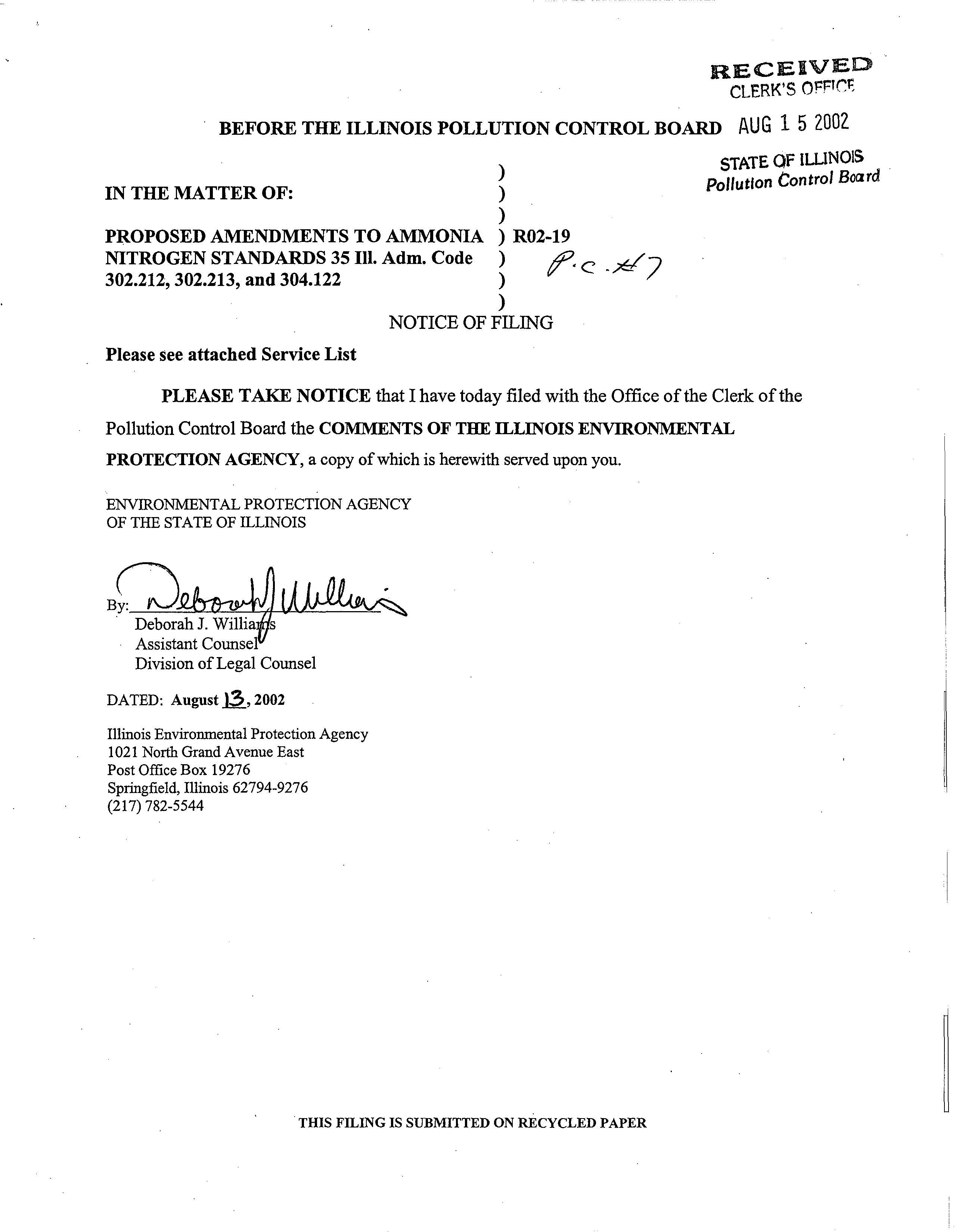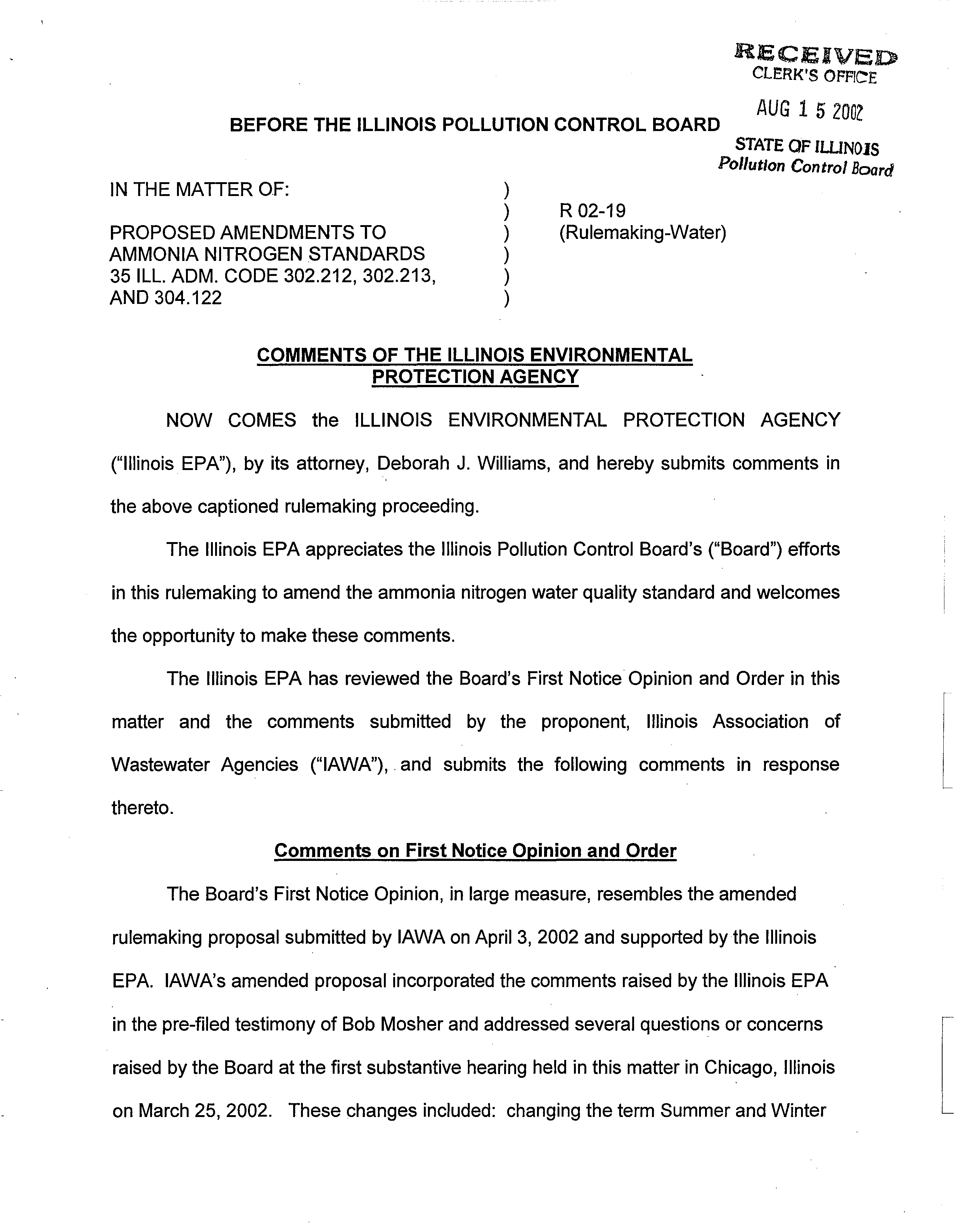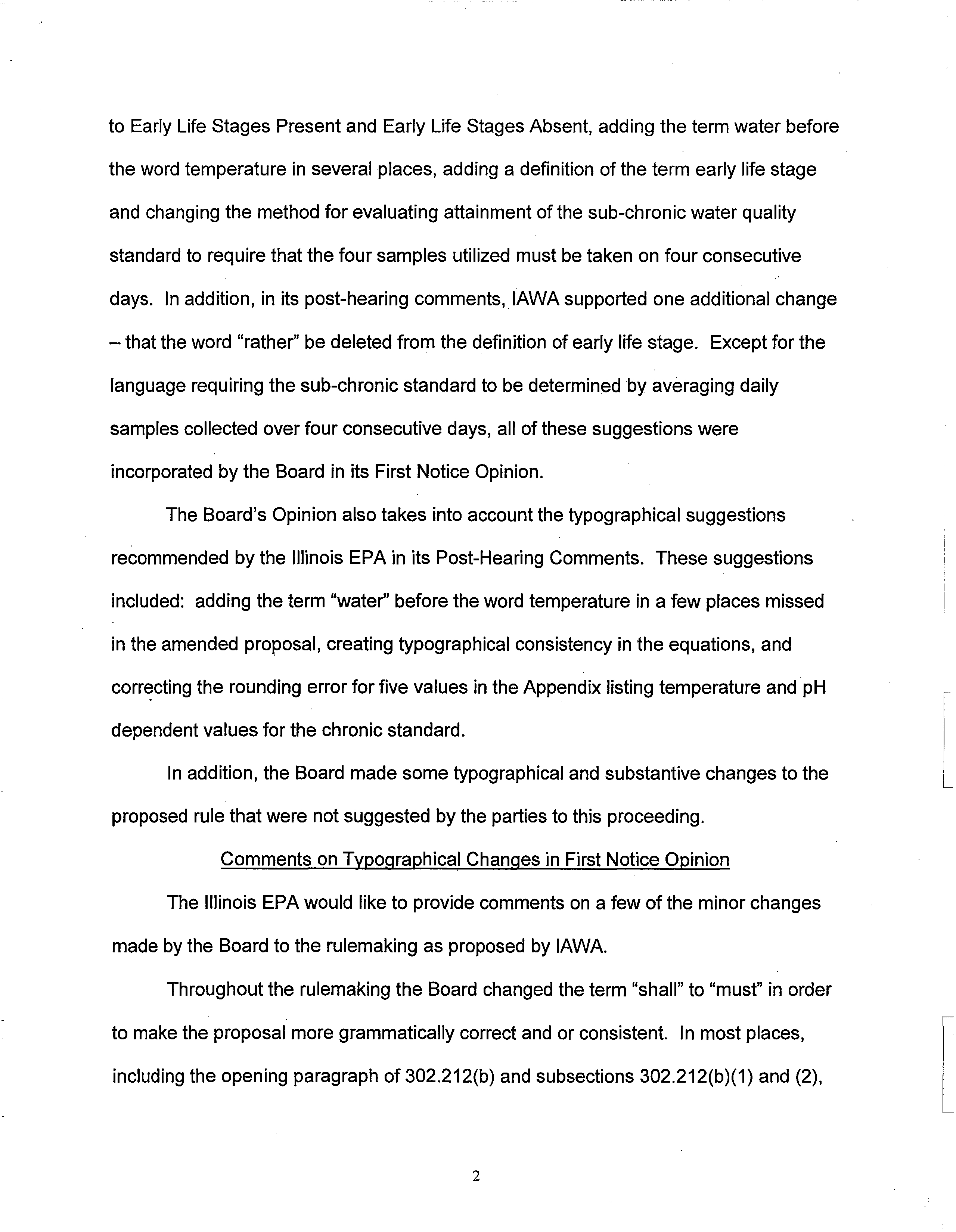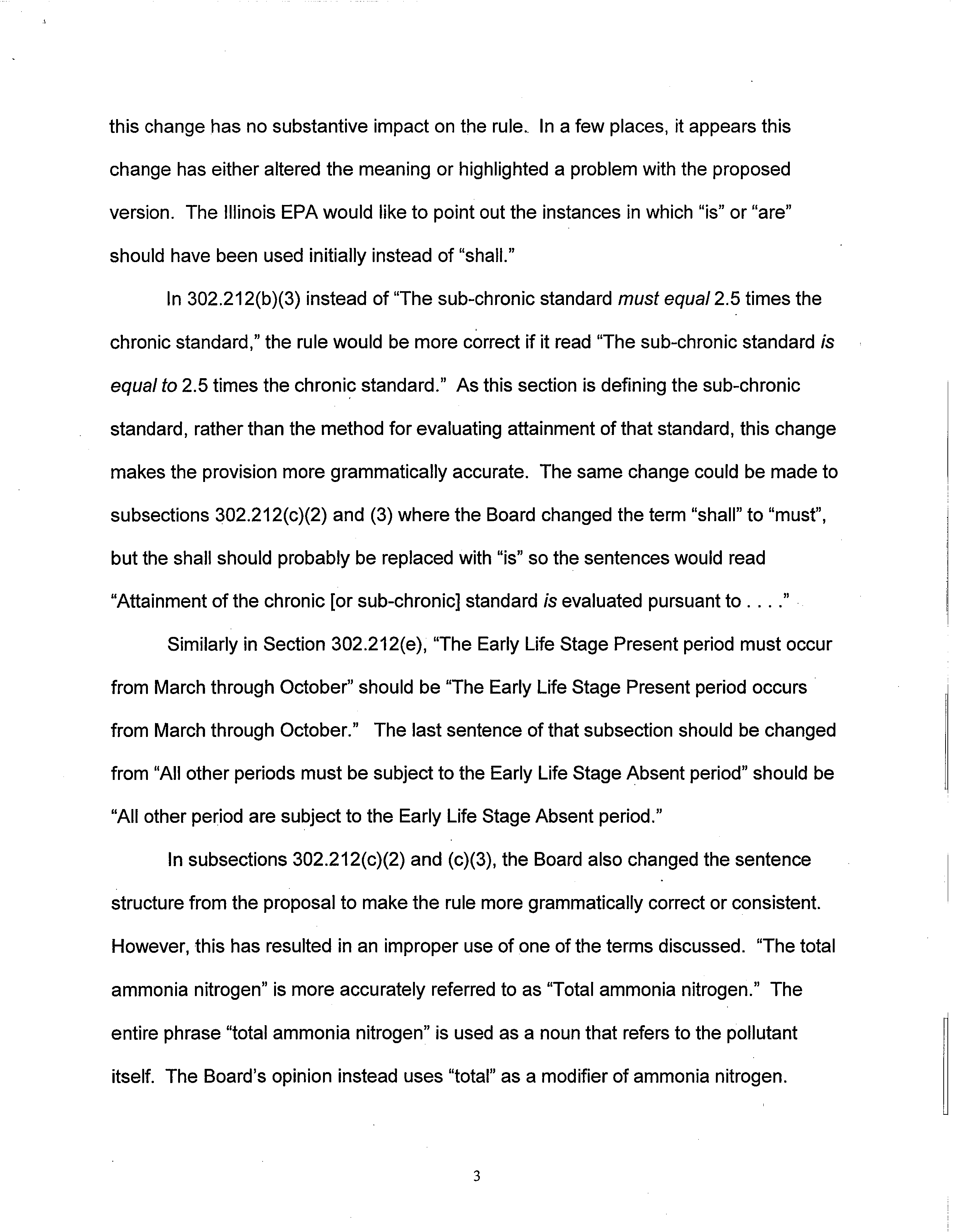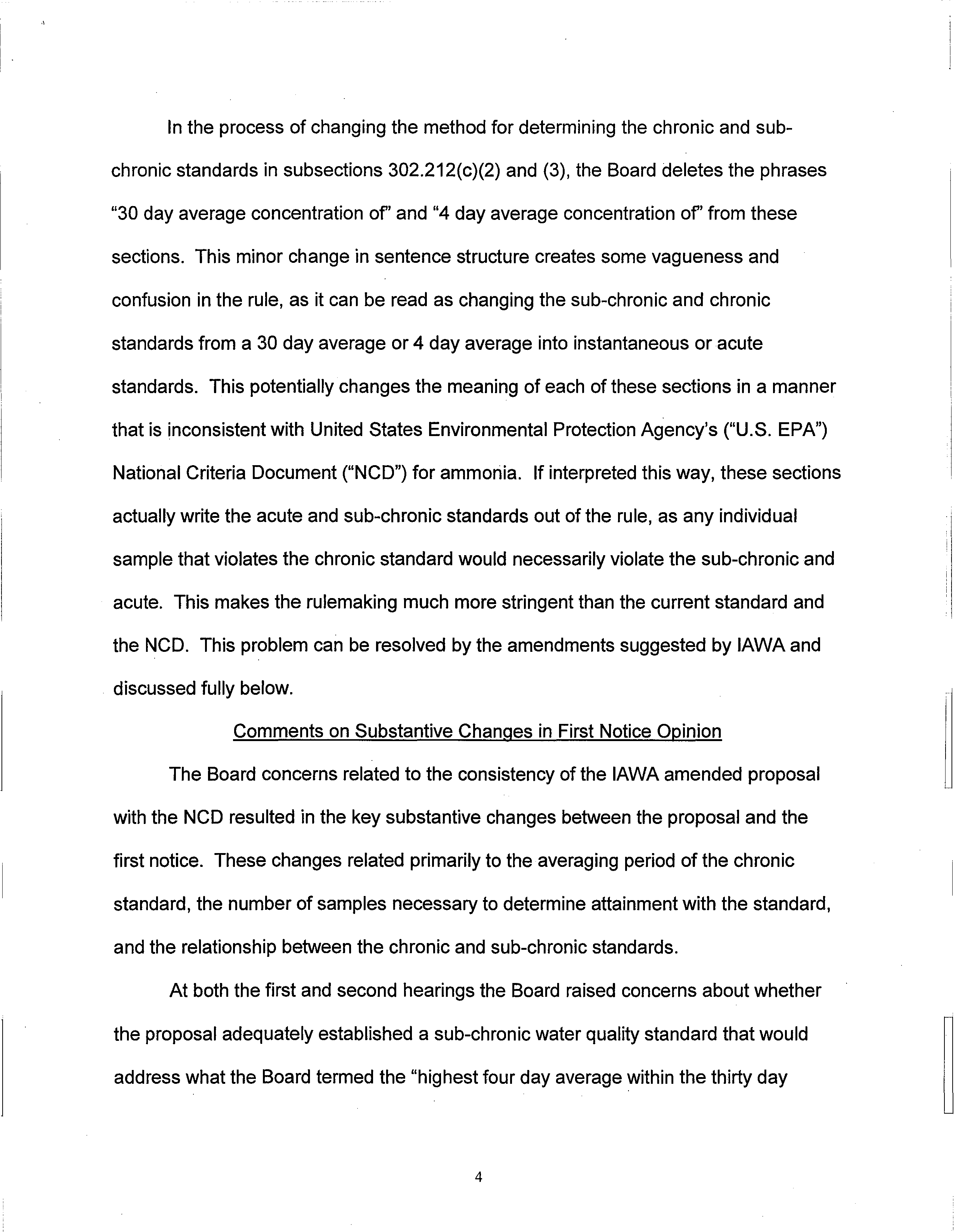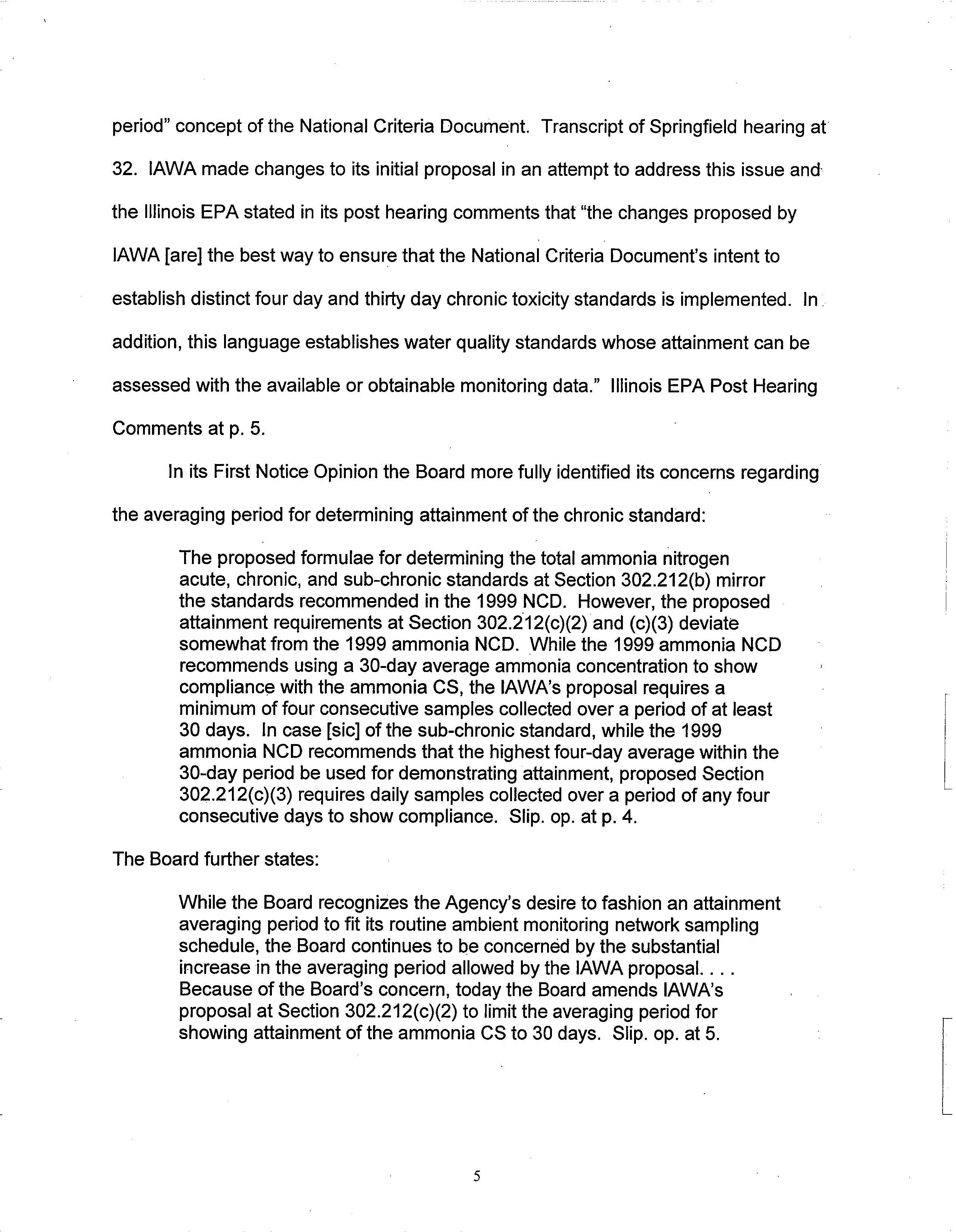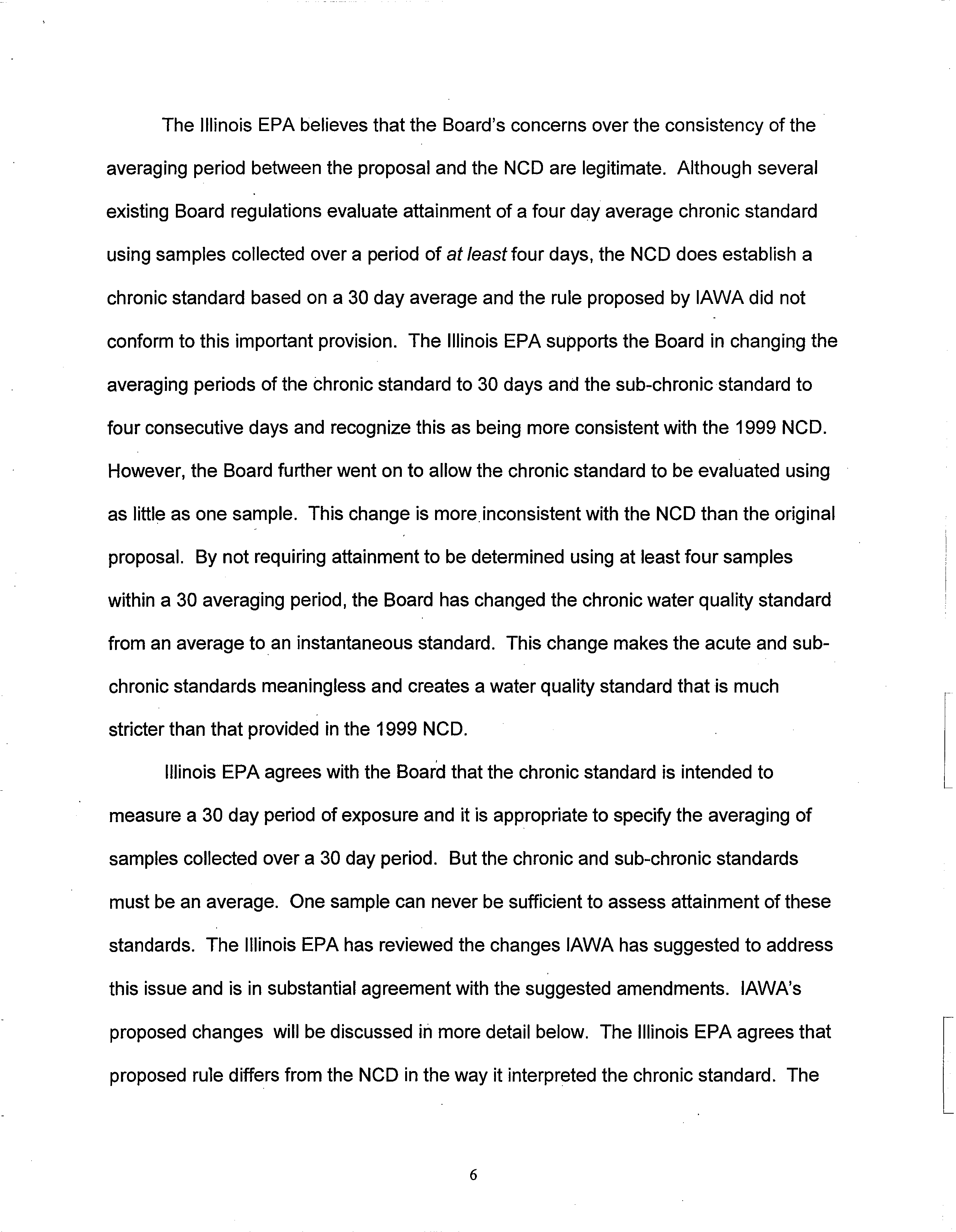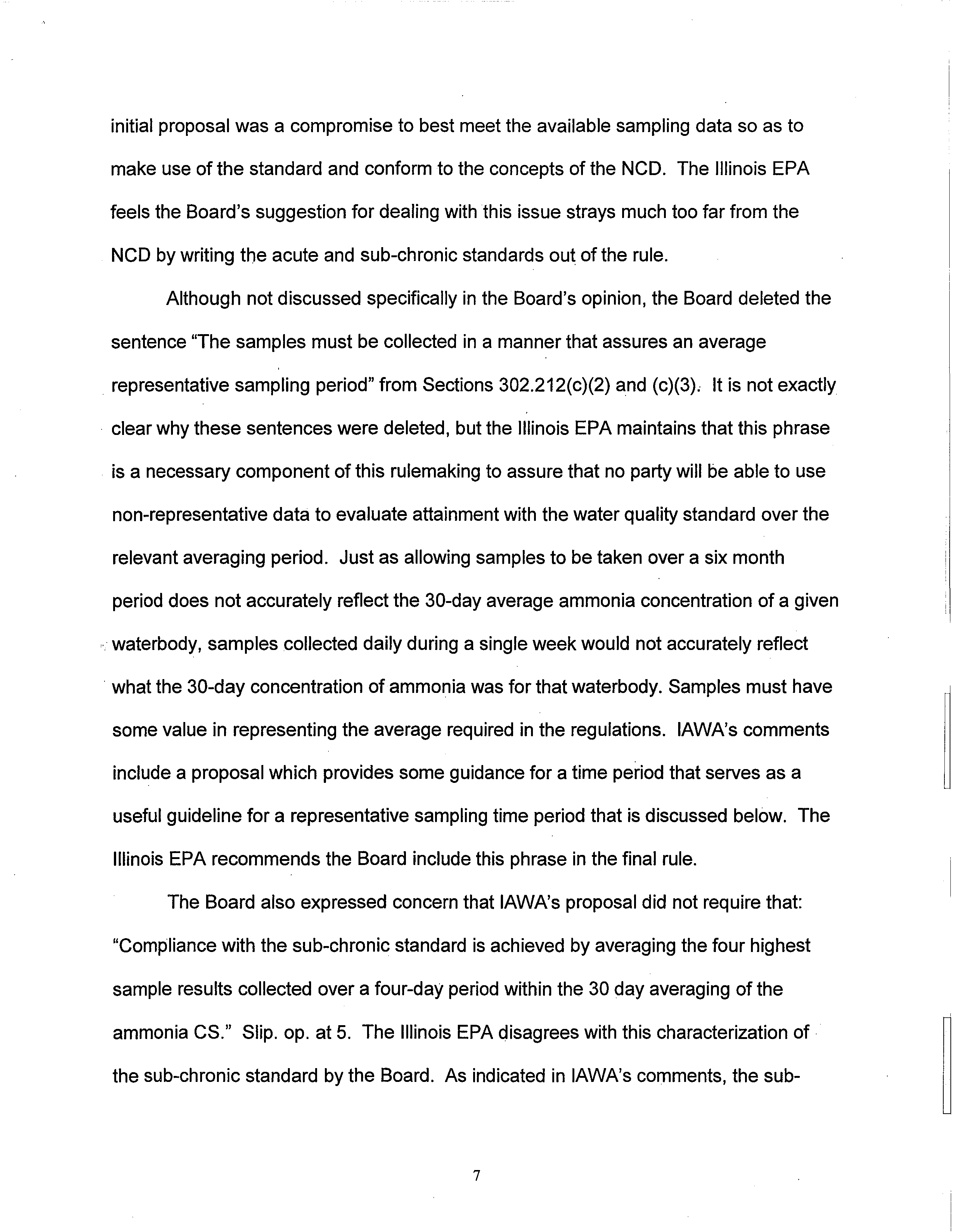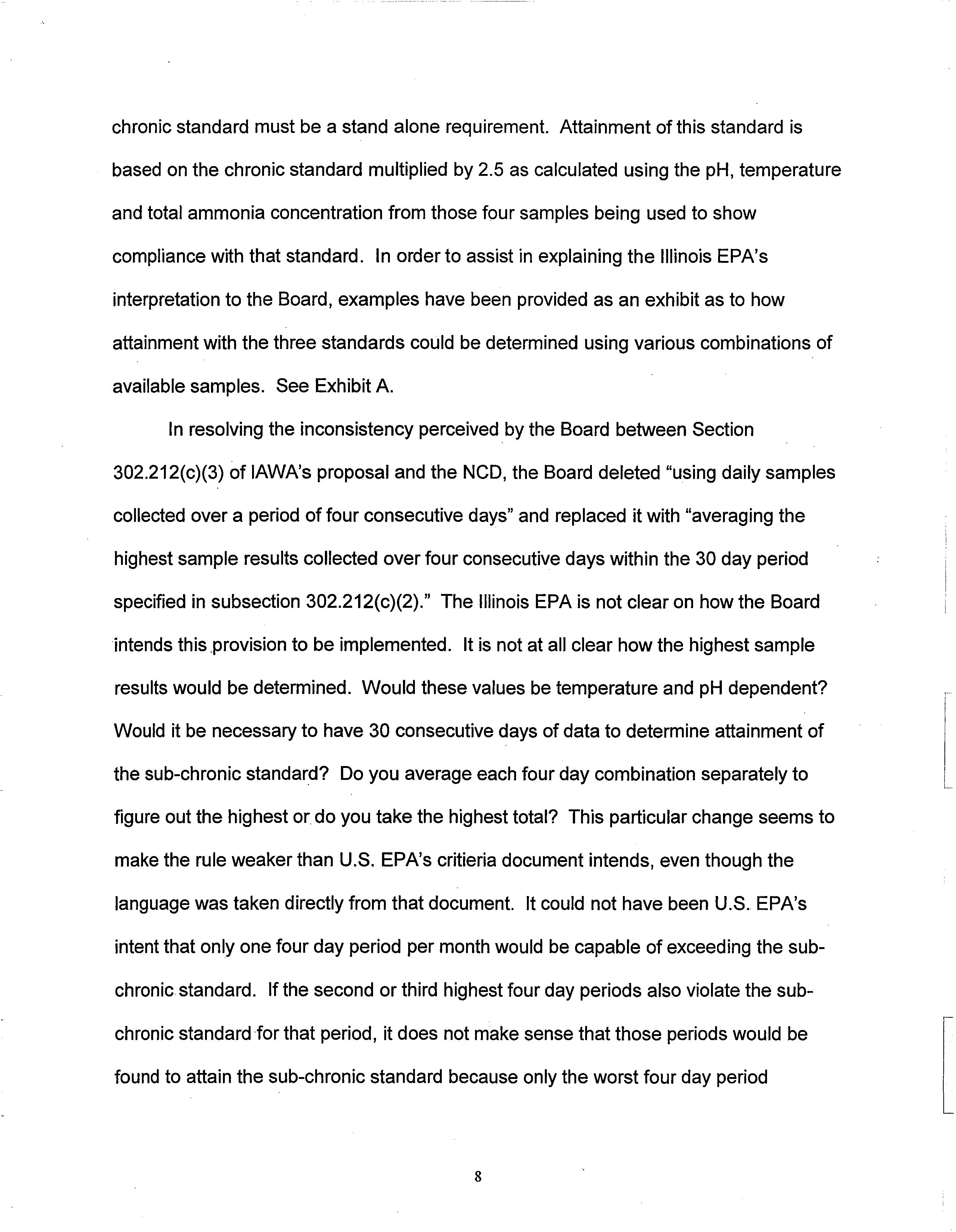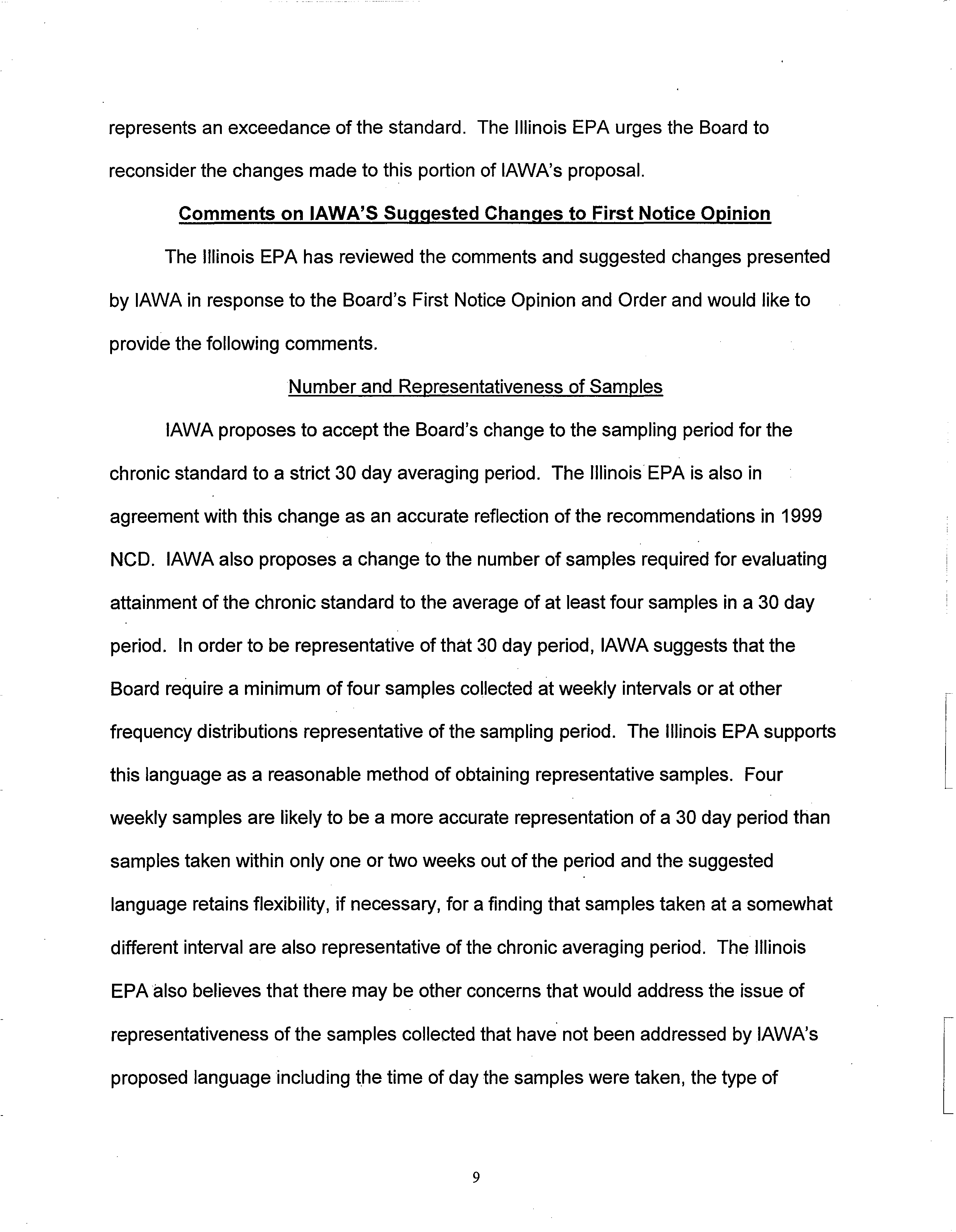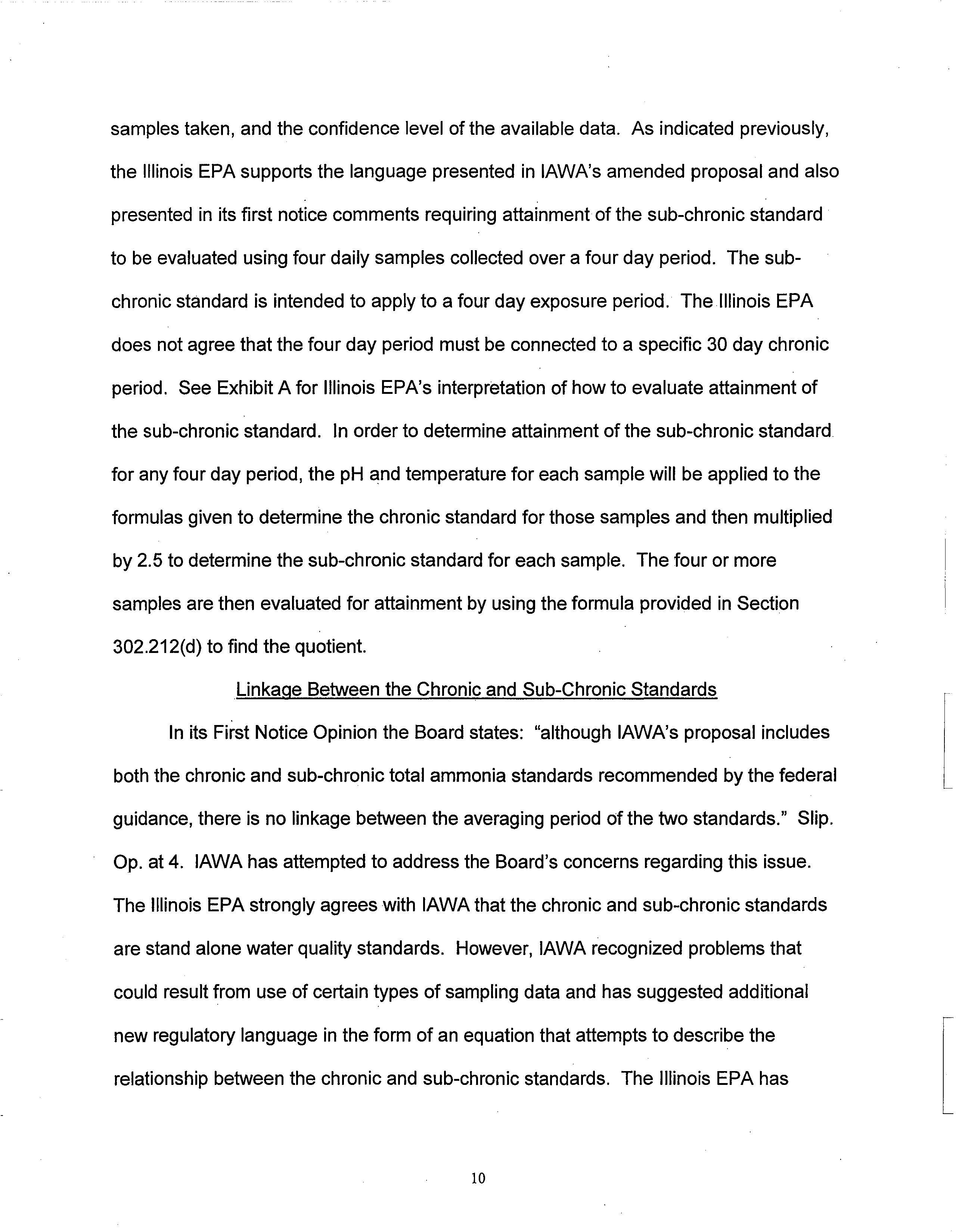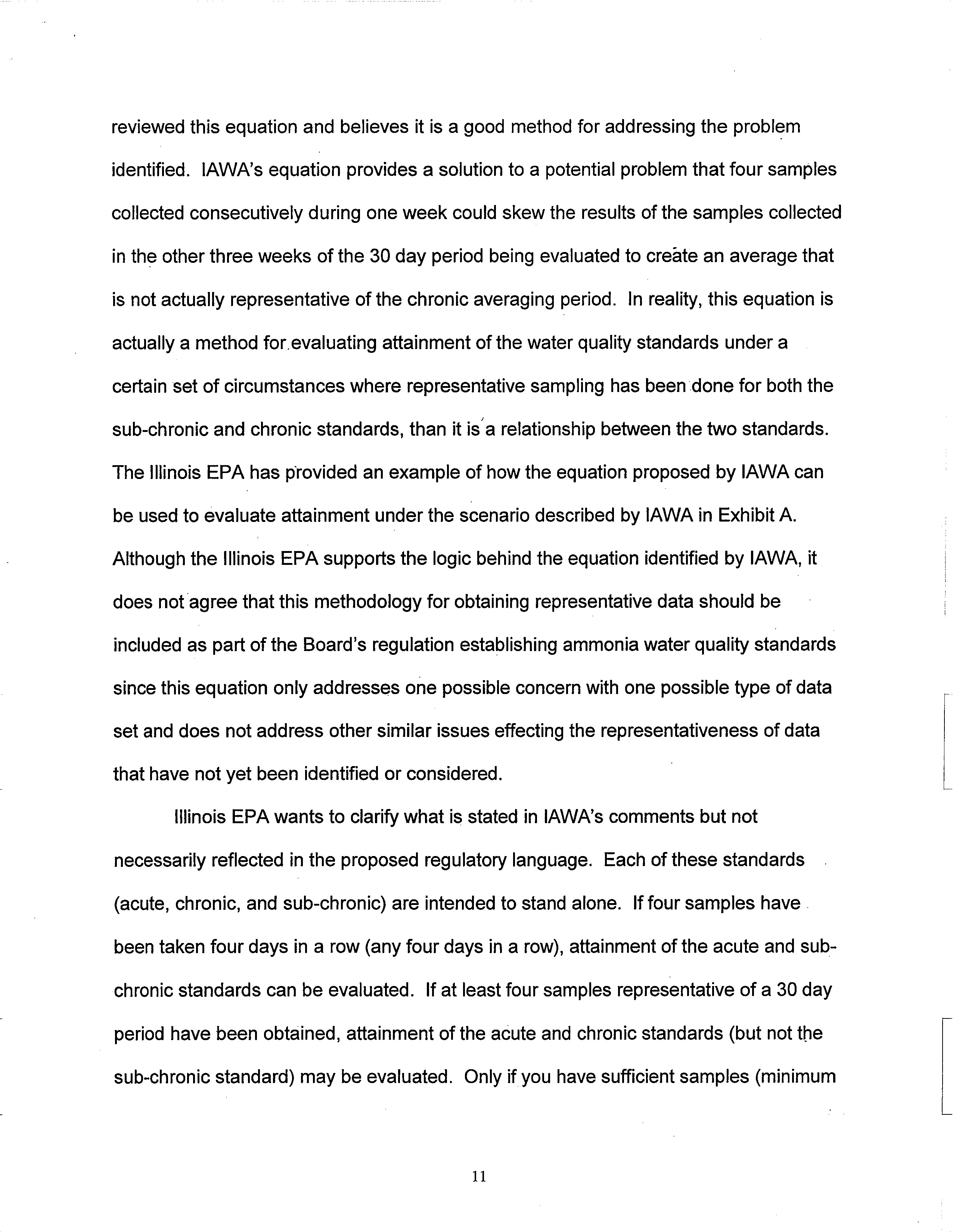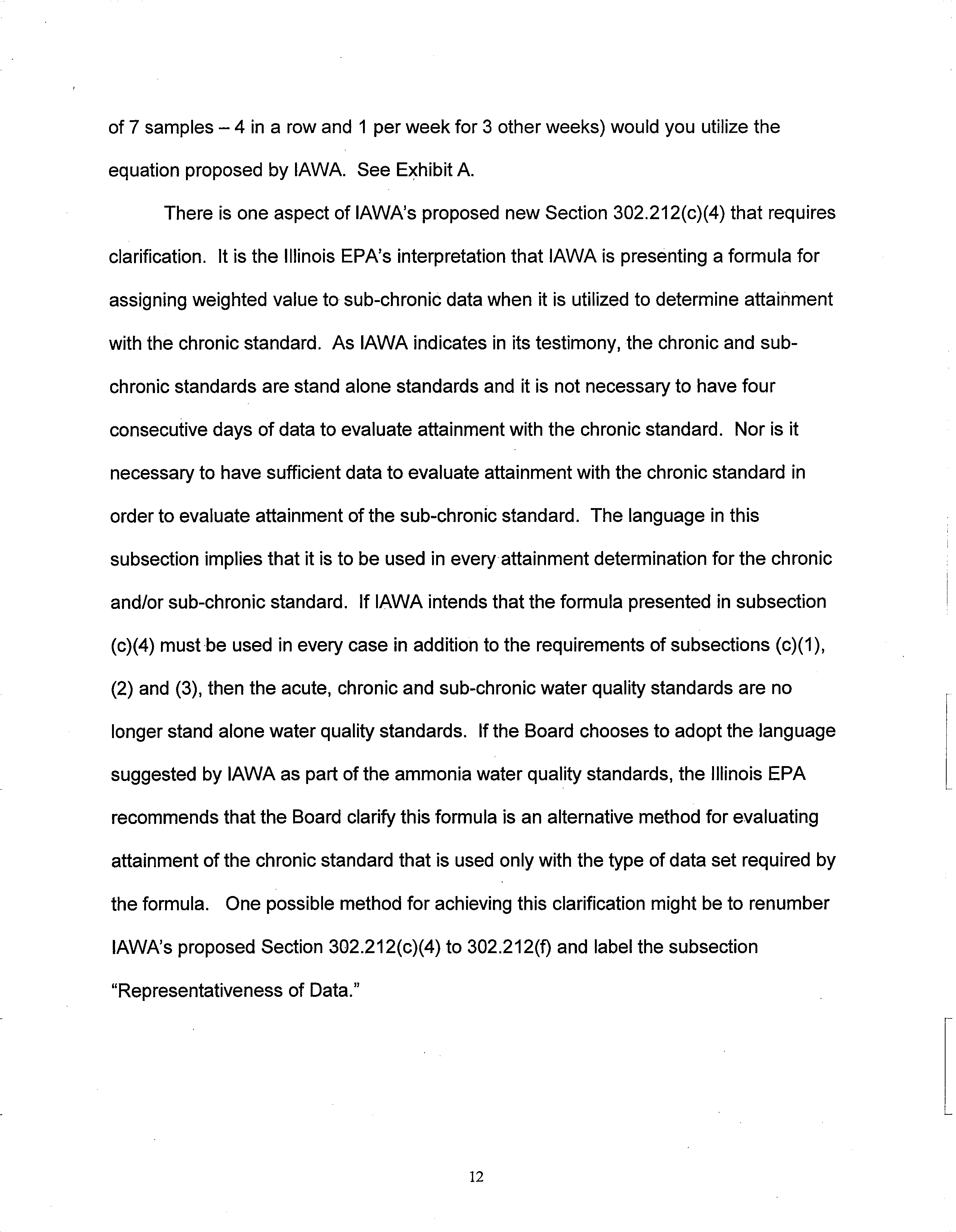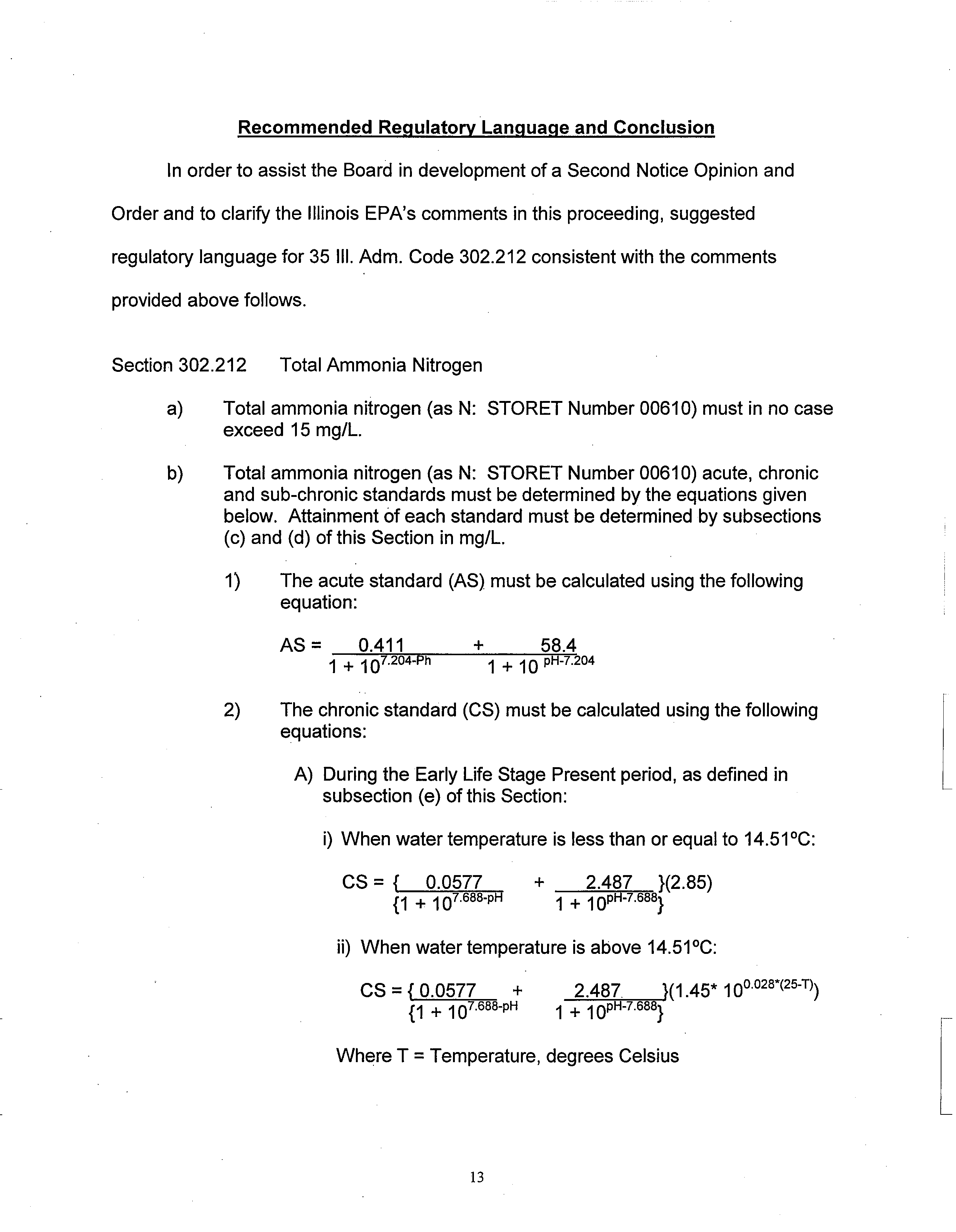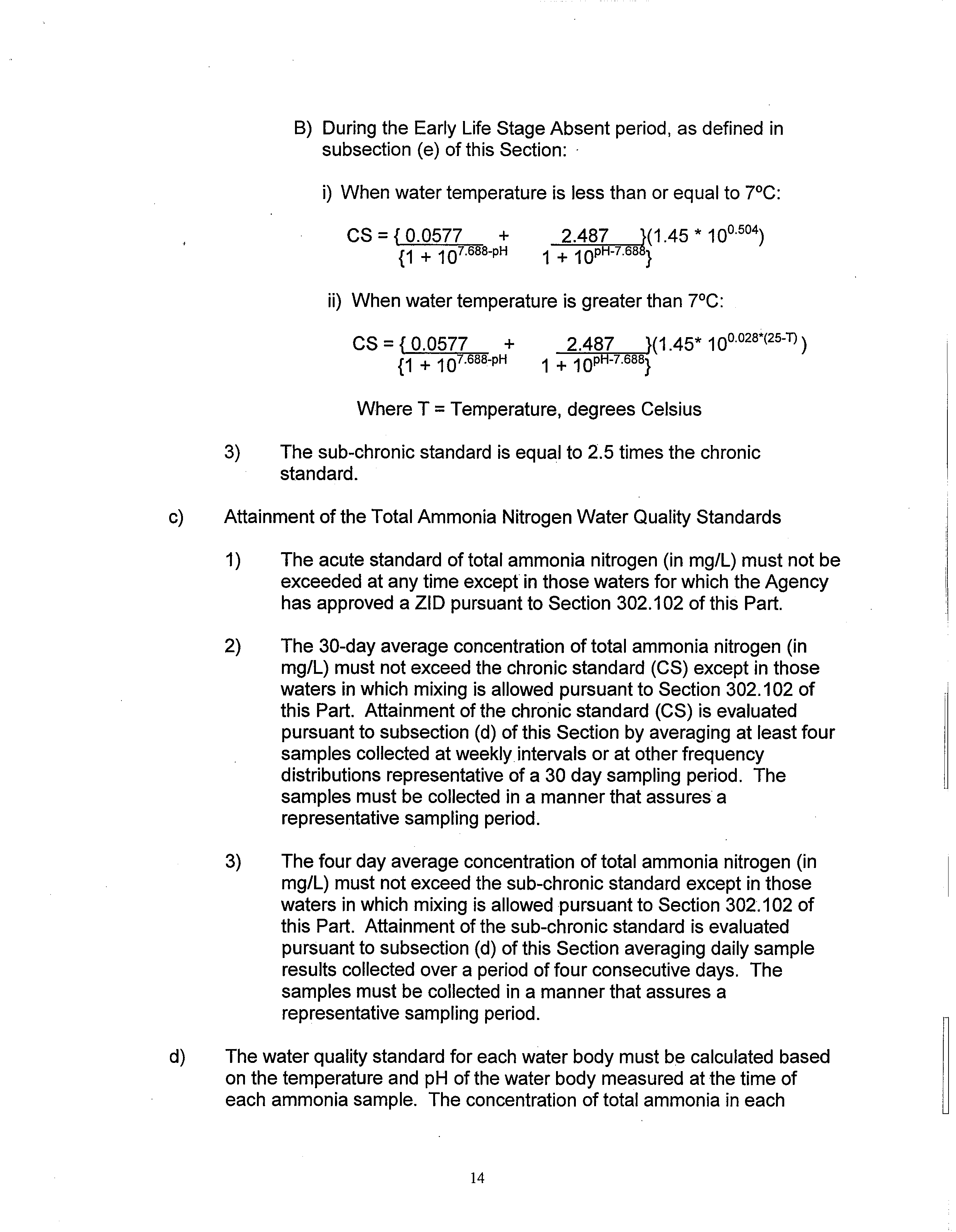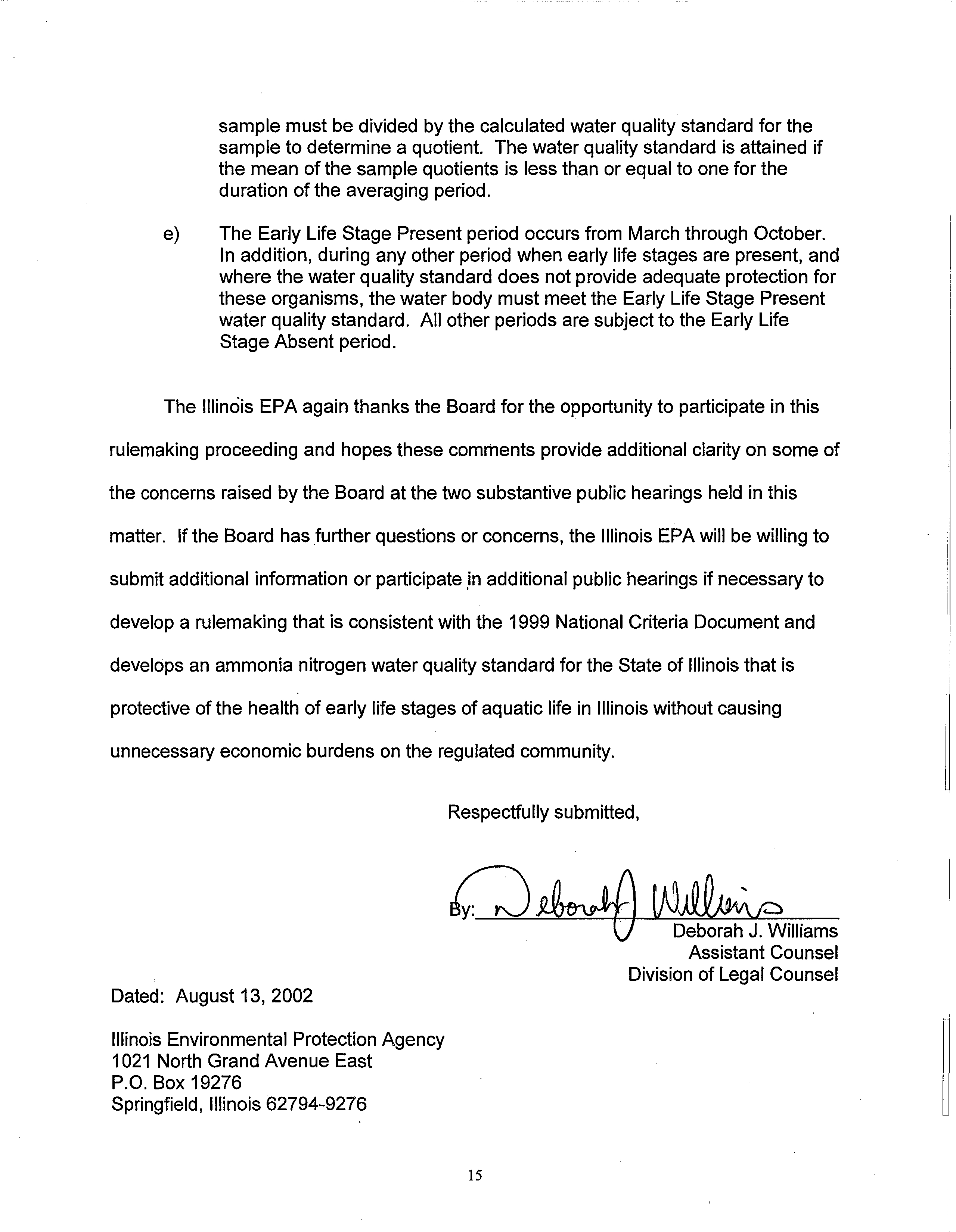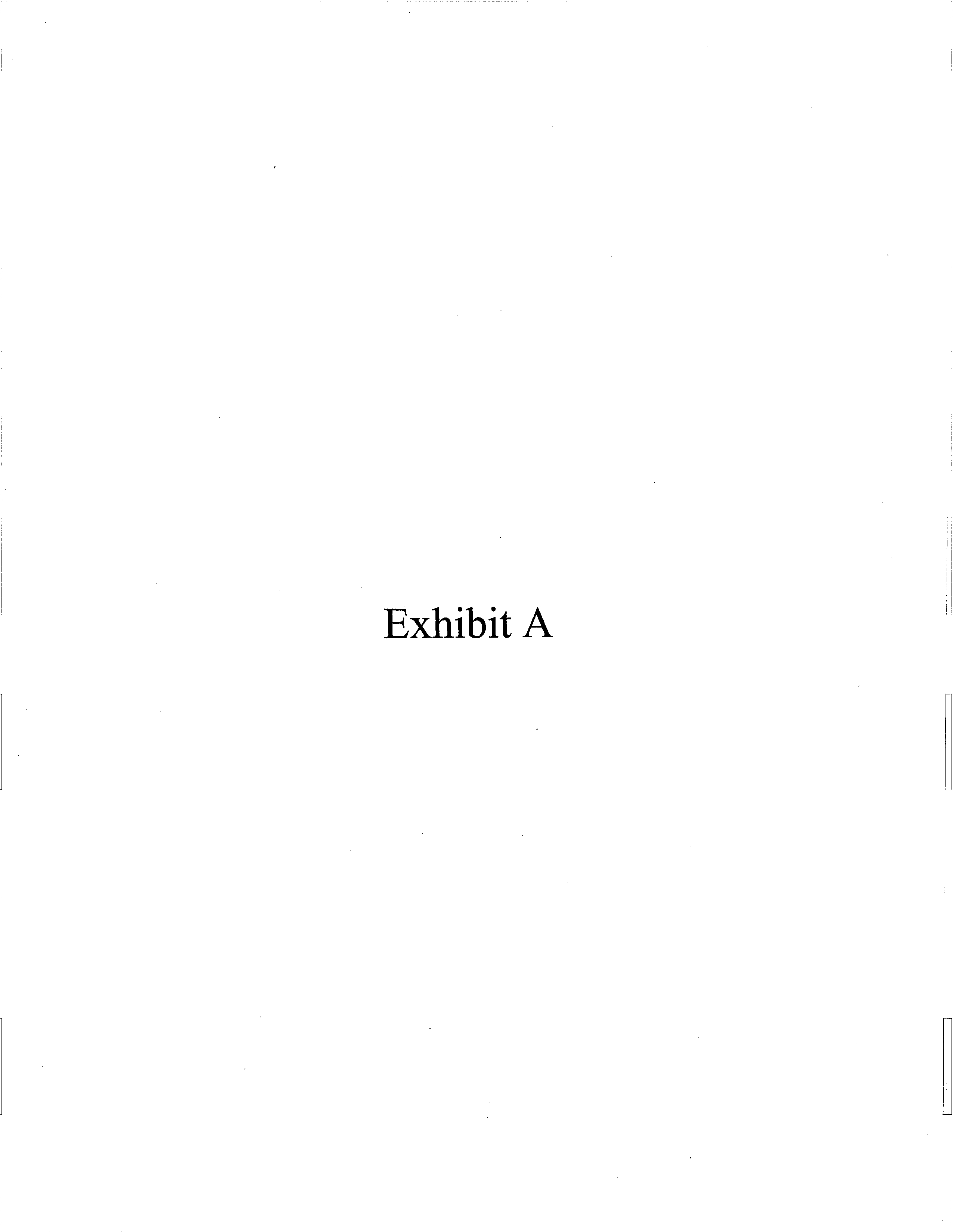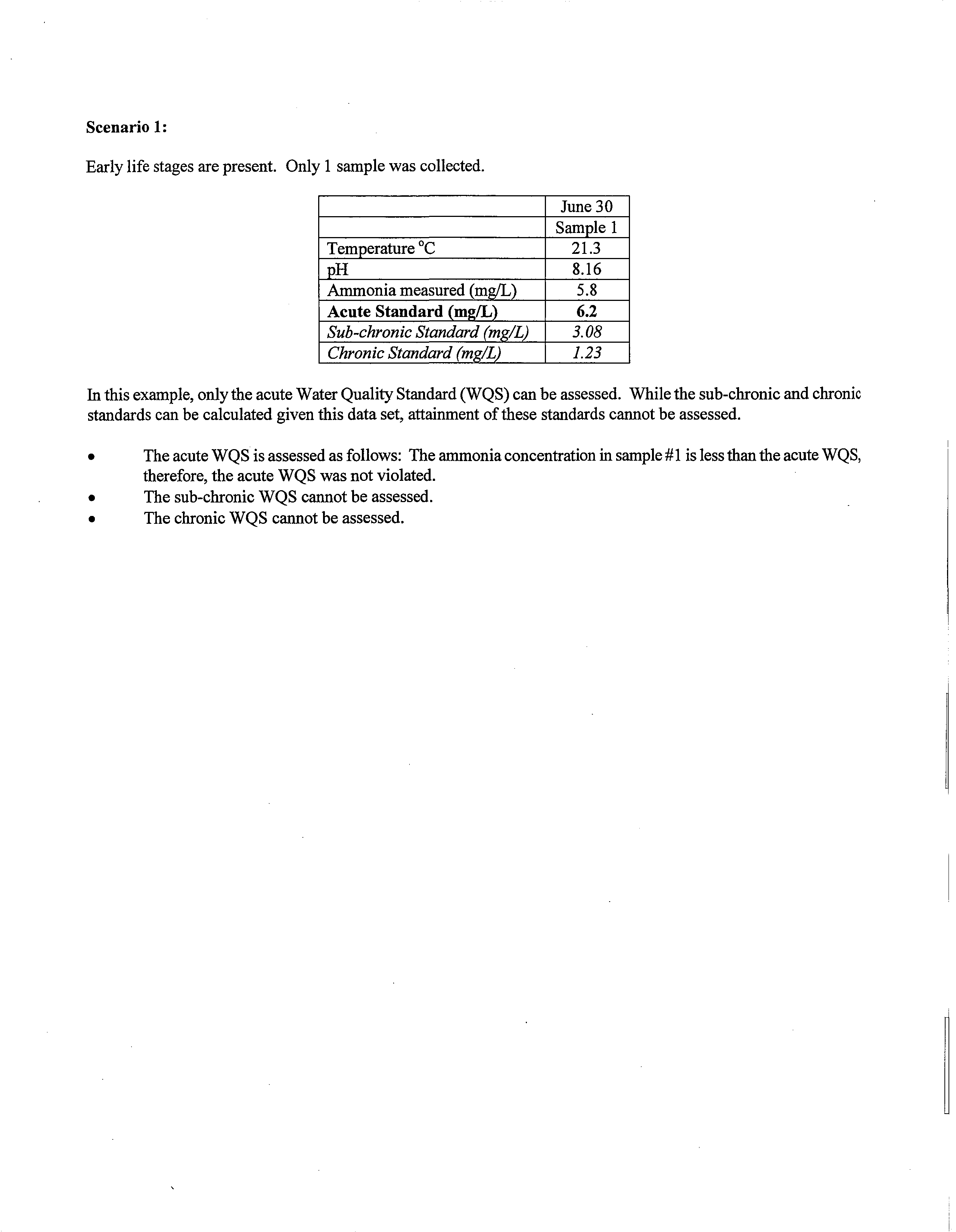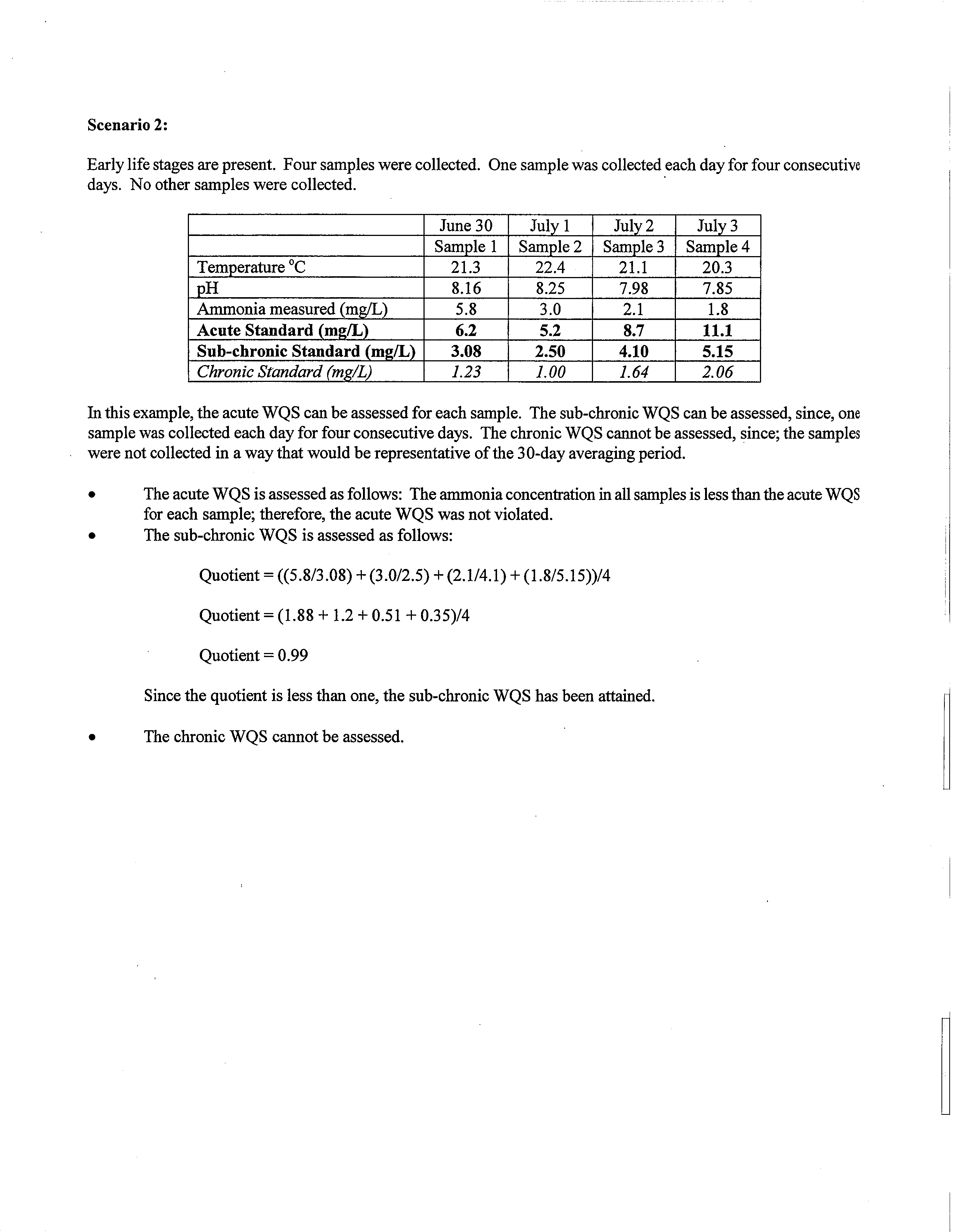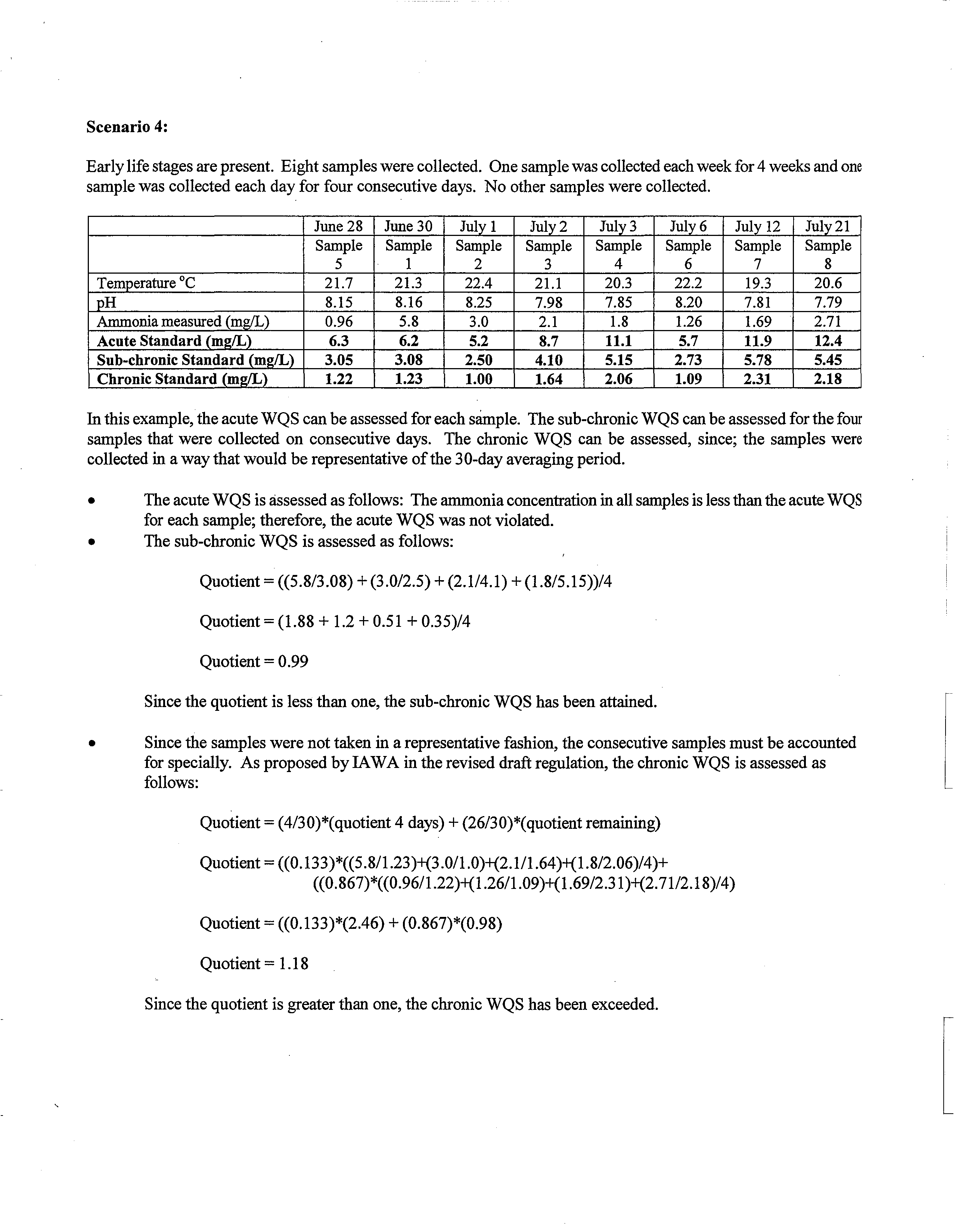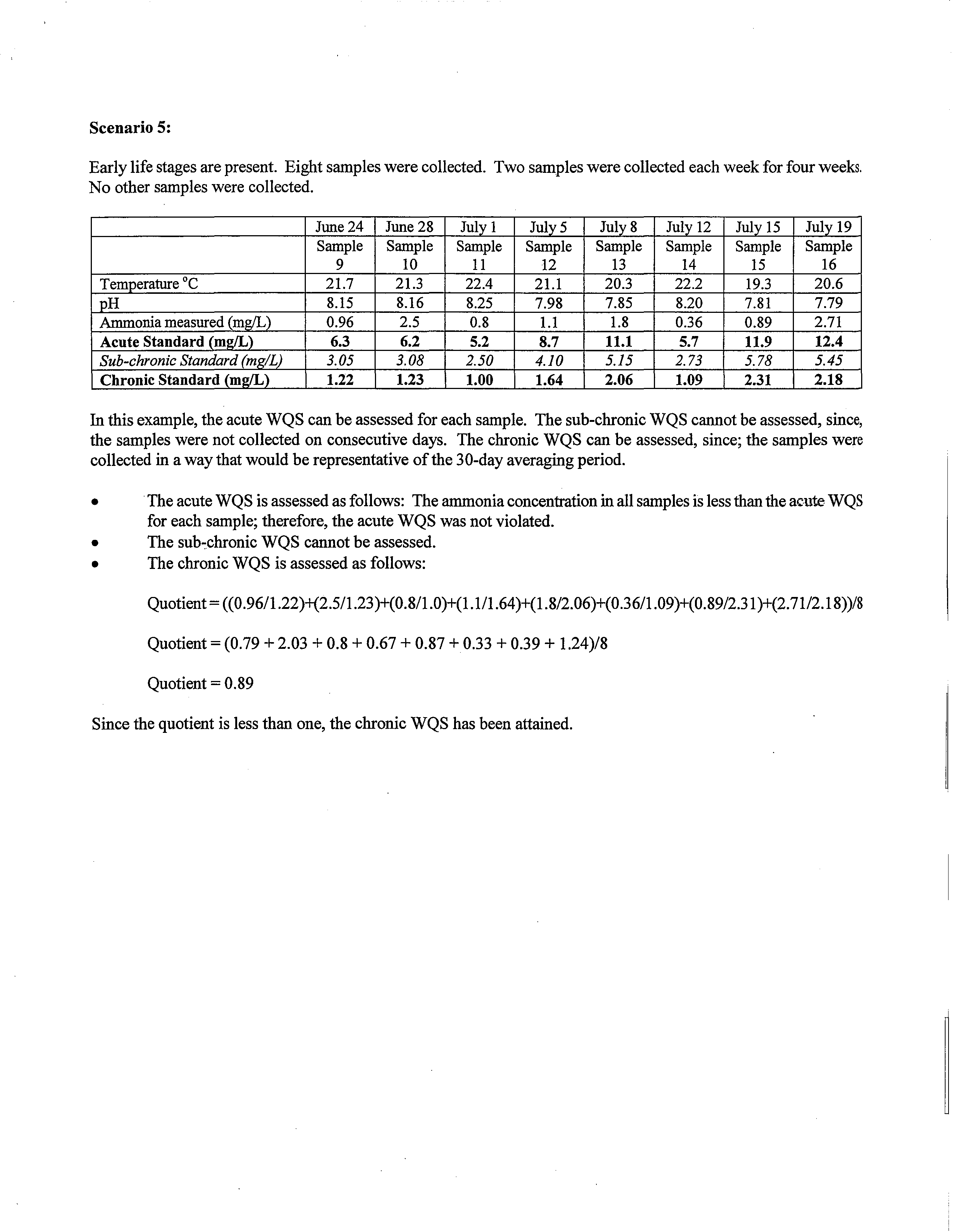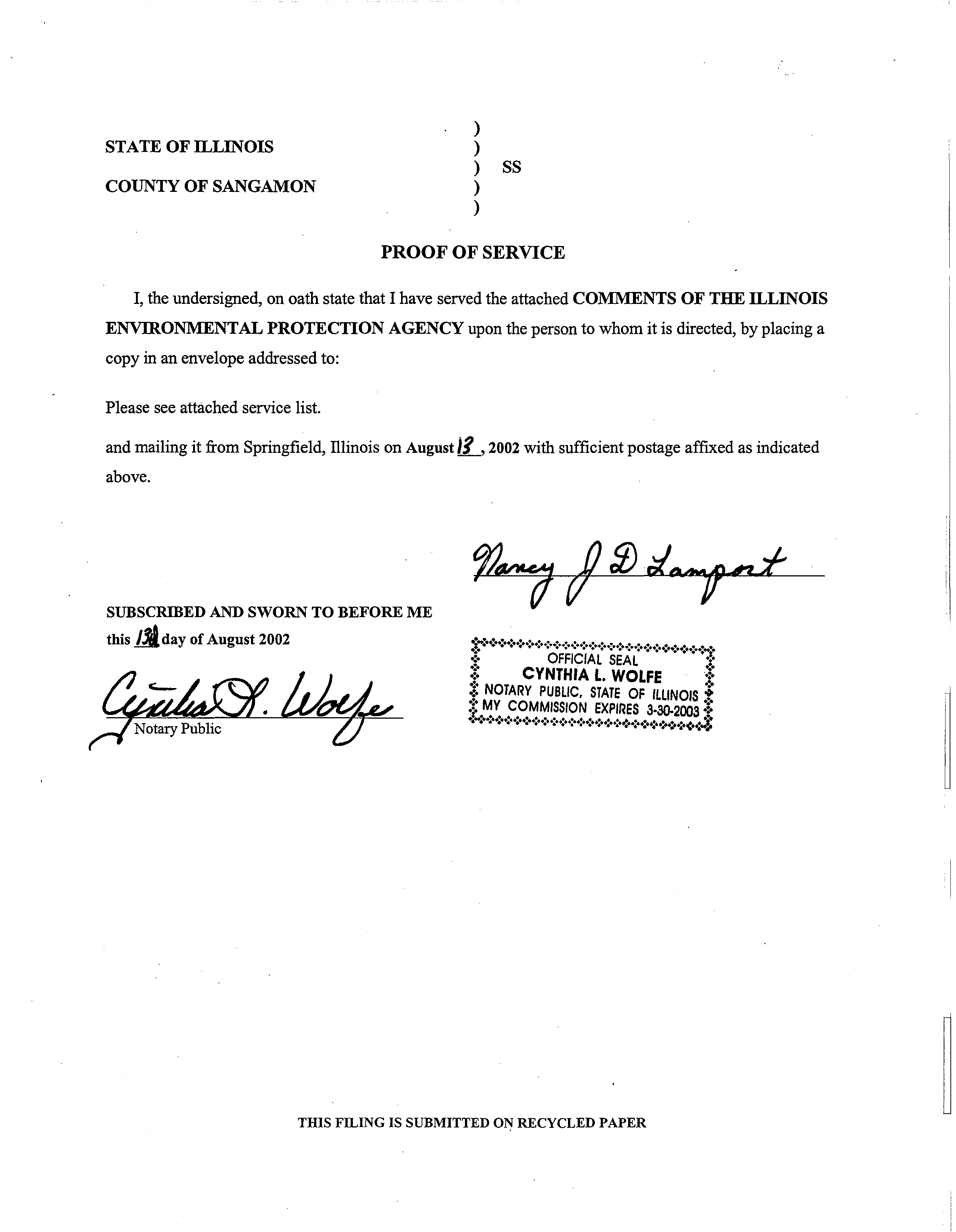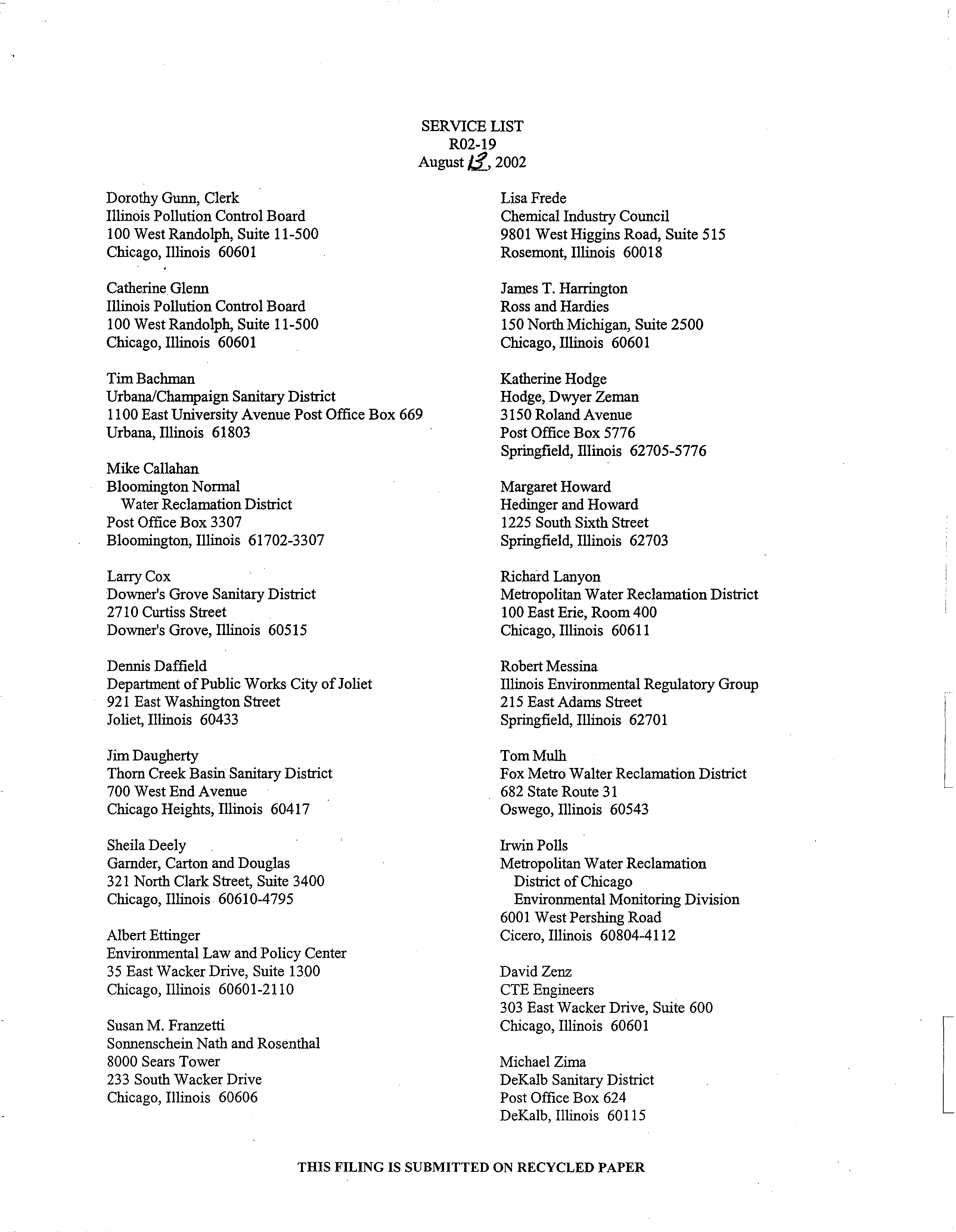RECEIVED
CLERK’S OFFT(~
BEFORE THE ILLINOIS POLLUTION CONTROL BOARD
AUG
1
52002
STATE QF
ILLINOIS
p
Ilution
Control Bocird
IN THE MATTER OF:
)
)
PROPOSED AMENDMENTS TO AMMONIA
)
R02-19
NITROGEN STANDARDS 35111. Adm. Code
)
302.212, 302.213,
and 304.122
)
)
NOTICE OF
FIIJNG
Please see attached Service List
PLEASE
TAKE
NOTICE
that Ihave today filed with the Office ofthe Clerk ofthe
Pollution
Control Board
the
COMMENTS OF
THE
ILLINOIS ENVIRONMENTAL
PROTECTION AGENCY, a
copy ofwhich is herewith
served
upon you.
ENVIRONMENTAL PROTECTION AGENCY
OF THE STATE OF ILLiNOIS
B~th~~/1C~Q
~
Deborah J. Wil1ia~~/s
Assistant Counsel
Division of Legal Counsel
DATED:
August
~,
2002
Illinois Environmental Protection Agency
1021
North GrandAvenue East
Post Office Box
19276
Springfield, Illinois 62794-9276
(217)
782-5544
THIS FILING IS SUBMITTED ON
RECYCLED PAPER
RECEiVED
CLERK’S OFF!~E
IWG
1
5
20C~
BEFORE THE
ILLINOIS POLLUTION CONTROL
BOARD
STATE OF IWNOJS
Pollution Control Board
IN
THE
MATTER
OF:
)
R02-19
PROPOSED AMENDMENTS TO
)
(Rulemaking-Water)
AMMONIA NITROGEN
STANDARDS
)
35
ILL. ADM. CODE 302.21 2, 302.213,
)
AND 304.122
)
COMMENTS OF THE
ILLINOIS ENVIRONMENTAL
PROTECTION AGENCY
NOW
COMES
the
ILLINOIS
ENVIRONMENTAL
PROTECTION
AGENCY
(“Illinois EPA”),
by
its attorney,
Deborah J.
Williams,
and
hereby submits comments
in
the above captioned
rulemaking proceeding.
The
Illinois EPA
appreciates the
Illinois
Pollution Control Board’s
(“Board”)
efforts
in this rulemaking to amend the ammonia nitrogen water quality standard and welcomes
the opportunity to make these comments.
The
Illinois
EPA
has reviewed
the
Board’s
First Notice Opinion and
Order
in
this
matter
and
the
comments
submitted
by
the
proponent,
Illinois
Association
of
Wastewater
Agencies
(“IAWA”),
and
submits
the
following
comments
in
response
thereto.
Comments on First Notice Opinion and Order
The Board’s
First Notice Opinion,
in
large measure, resembles the amended
rulemaking proposal submitted by IAWA on April
3, 2002 and supported by the
Illinois
EPA.
IAWA’s amended proposal incorporated the comments raised by the
Illinois
EPA
in the pre-filed testimony of Bob Mosher and addressed several questions or concerns
raised by the
Board at the first substantive hearing held
in this matter in
Chicago,
Illinois
on March 25,
2002.
These changes included:
changing the
term
Summer and Winter
to Early Life Stages Present and Early Life Stages Absent,
adding the term water before
the word temperature in several places,
adding
a definition of the term
early
life stage
and changing the method for evaluating attainment of the sub-chronic water quality
standard to require that the four samples utilized must be taken on four consecutive
days.
In addition,
in
its post-hearing comments, IAWA supported one additional change
—
that the word “rather” be deleted from the
definition of early
life stage.
Except for the
language requiring the sub-chronic standard to be determined
by averaging
daily
samples collected
over four consecutive days,
all of these suggestions were
incorporated
by the
Board
in
its First Notice Opinion.
The Board’s Opinion also takes
into account the typographical suggestions
recommended
by the
Illinois
EPA in
its
Post-Hearing Comments.
These suggestions
included:
adding the term
“water” before the word temperature
in
a few places missed
in the amended
proposal, creating typographical consistency in the equations, and
correcting the rounding error for five values
in the Appendix listing temperature and pH
dependent values for the chronic standard.
In addition, the
Board made some typographical and substantive changes to the
proposed rule that were
not suggested by the parties to this proceeding.
Comments on Typographical Changes in
First Notice Opinion
The Illinois
EPA would like to provide comments on a few of the minor changes
made by the
Board to the
rulemaking
as proposed
by IAWA.
Throughout the
rulemaking the
Board changed the term
“shall” to “must” in
order
to make the proposal more grammatically correct and or consistent.
In most
places,
including the opening paragraph of 302.212(b) and subsections 302.212(b)(1) and (2),
2
this change has no substantive
impact on the
rule..
In
a few places,
it appears this
change has either altered the meaning or highlighted a problem with
the proposed
version.
The Illinois
EPA would like to point out the instances in which “is” or “are”
should
have been
used initially instead of “shall.”
In 302.212(b)(3) instead of “The sub-chronic standard
must equal
2.5 times the
chronic standard,” the rule would be more correct if it read “The sub-chronic standard
is
equal to
2.5 times the chronic standard.”
As this section
is defining the sub-chronic
standard, rather than the method for evaluating attainment of that standard, this change
makes
the
provision more grammatically accurate.
The same change could
be made to
subsections 302.212(c)(2) and
(3) where the
Board changed the term “shall” to “must”,
but the shall should probably be replaced with
“is” so the sentences would
read
“Attainment of the chronic or
sub-chronic
standard
is
evaluated pursuant to.
.
.
Similarly
in Section 302.212(e),
“The Early Life Stage Present period
must occur
from
March through October” should
be “The Early Life Stage Present period occurs
from March through October.”
The last sentence of that subsection
should
be changed
from “All other periods must
be subject to the Early Life Stage Absent period” should be
“All other period are subject to the
Early Life Stage Absent period.”
In subsections 302.212(c)(2)
and (c)(3), the Board also changed the sentence
structure from the proposal to make the rule more grammatically correct or consistent.
However, this has resulted
in an improper use of one of the terms discussed.
“The total
ammonia nitrogen”
is more accurately
referred to as “Total ammonia nitrogen.”
The
entire phrase “total ammonia nitrogen” is
used as a noun that refers to the pollutant
itself.
The Board’s opinion
instead uses “total” as a modifier of ammonia nitrogen.
3
In the process of changing the method for determining the chronic and sub-
chronic standards in subsections 302.212(c)(2) and (3), the
Board deletes the phrases
“30 day average concentration
of” and “4 day average concentration of” from these
sections.
This minor change in sentence structure creates some vagueness and
confusion
in the
rule, as it can be
read as changing the sub-chronic and chronic
standards from
a 30 day average or 4 day average into instantaneous or acute
standards.
This potentially changes the
meaning of each
of these sections in a manner
that is inconsistent with
United States
Environmental
Protection Agency’s (“U.S. EPA”)
National Criteria Document (“NCD”) for ammonia.
If interpreted this way, these sections
actually write the acute and sub-chronic standards out of the
rule, as any individual
sample that violates the chronic standard would necessarily violate the sub-chronic and
acute.
This makes the rulemaking much more stringent than the current standard and
the
NCD.
This problem can be resolved by the amendments suggested by IAWA and
discussed fully
below.
Comments on Substantive Changes in
First Notice Opinion
The Board concerns related to the consistency of the
IAWA amended proposal
with the
NCD
resulted in
the key substantive changes between the proposal and the
first notice.
These changes related primarily to the
averaging period of the chronic
standard, the number of samples necessary to determine attainment with the standard,
and the relationship between the chronic and sub-chronic standards.
At both the first and second hearings the
Board raised concerns about whether
the proposal adequately established
a sub-chronic water quality standard that would
address what the
Board termed the “highest four day average within the thirty day
4
period” concept of the
National Criteria Document.
Transcript of Springfield hearing at
32.
IAWA made changes to its
initial proposal in
an attempt to address this issue
and
the
Illinois EPA stated
in
its
post hearing comments that “the changes proposed
by
IAWA are
the best way to ensure that the National Criteria Document’s intent to
establish distinct four day and thirty day chronic toxicity standards is implemented.
In.
addition, this language establishes water quality standards whose attainment can
be
assessed with the
available or obtainable monitoring data.”
Illinois EPA
Post Hearing
Comments at p. 5.
In its
First Notice Opinion the Board more fully identified
its concerns regarding
the
averaging
period for determining attainment of the chronic standard:
The proposed formulae for determining the total ammonia nitrogen
acute, chronic,
and sub-chronic standards at Section 302.21 2(b) mirror
the standards recommended
in the
1999 NCD.
However, the proposed
attainment requirements at Section 302.212(c)(2) and (c)(3)
deviate
somewhat from the
1999 ammonia
NCD.
While the
1999 ammonia NCD
recommends
using
a 30-day average ammonia concentration to show
compliance with
the ammonia CS, the
IAWA’s proposal
requires a
minimum of four consecutive samples collected over a
period of at least
30 days.
In case sic
of the sub-chronic standard, while the
1999
ammonia
NCD
recommends that the highest four-day average within the
30-day period
be used for demonstrating attainment, proposed Section
302.212(c)(3)
requires daily samples collected over
a period of any four
consecutive days to show compliance.
Slip.
op.
at p. 4.
The Board further states:
While the
Board recognizes the Agency’s desire to fashion an attainment
averaging
period to fit its routine ambient monitoring network sampling
schedule, the
Board continues to be concerned by the substantial
increase in the
averaging
period allowed
by the
IAWA proposal..
.
Because of the
Board’s concern, today the
Board amends
IAWA’s
proposal at Section 302.212(c)(2) to limit the averaging
period for
showing attainment of the ammonia CS to 30 days.
Slip. op.
at 5.
5
The Illinois
EPA believes that the
Board’s concerns over the consistency of the
averaging
period between the proposal and the
NCD are
legitimate.
Although several
existing
Board
regulations evaluate attainment of a four day average chronic standard
using samples collected over a
period of
at least
four days,
the
NCD does establish
a
chronic standard based on a 30 day average and the
rule proposed by IAWA did not
conform to this important provision.
The
Illinois
EPA supports the
Board
in changing the
averaging
periods of the óhronic standard to 30 days and the sub-chronic standard to
four consecutive days and
recognize this as being more consistent with the
1999 NCD.
However, the Board further went on to allow the chronic standard to be evaluated using
as little as one sample.
This change is more.inconsistent with
the
NCD than the original
proposal.
By not
requiring attainment to be determined
using at least four samples
within a
30 averaging period, the Board has changed the chronic water quality standard
from an average to an instantaneous standard.
This change makes the acute and sub-
chronic standards
meaningless and creates a water quality standard that
is much
stricter than that provided
in the
1999 NCD.
Illinois EPA
agrees with the
Board that the chronic standard
is intended to
measure a 30 day period of exposure and it is appropriate to specify the averaging of
samples collected over a
30 day period.
But the chronic and sub-chronic standards
must be an average.
One sample can never be sufficient to assess attainment of these
standards.
The
Illinois EPA has reviewed
the changes IAWA has suggested to address
this issue and
is
in substantial agreement with
the suggested amendments.
IAWA’s
proposed changes
will be discussed
in
more detail
below.
The Illinois
EPA agrees that
proposed rule differs from the
NCD in the way it interpreted the chronic standard.
The
6
initial proposal was a compromise to best meet the available sampling
data so as to
make use of the standard and conform to the
concepts of the
NCD.
The Illinois
EPA
feels the Board’s suggestion for dealing with this issue strays much too far from the
NCD by writing the acute and
sub-chronic standards out of the
rule.
Although not discussed specifically in
the
Board’s opinion, the Board
deleted the
sentence “The samples must be collected
in
a manner that assures an average
representative sampling
period” from
Sections 302.212(c)(2) and (c)(3);
It
is not exactly
clear why these sentences were
deleted,
but the
Illinois
EPA maintains that this phrase
is
a necessary component of this rulemaking to assure that no party will
be able to
use
non-representative data to evaluate attainment with the water quality standard over the
relevant averaging period.
Just as allowing samples to be taken over a six month
period does
not accurately reflect the 30-day average ammonia concentration of a given
waterbody, samples collected daily during a single week would not accurately reflect
what the 30-day concentration of ammonia was for that waterbody. Samples must have
some value
in
representing the average required in the
regulations.
IAWA’s comments
include a proposal which provides some guidance for a time period that serves as a
useful guideline for a representative sampling
time period that is discussed
below.
The
Illinois
EPA
recommends the
Board include this phrase in the final rule.
The Board also expressed
concern that IAWA’s proposal did not require that:
“Compliance with
the sub-chronic standard
is achieved
by averaging
the four highest
sample results collected
over a four-day period within the 30 day averaging of the
ammonia CS.”
Slip.
op.
at 5.
The Illinois
EPA disagrees with
this characterization of~
the sub-chronic standard by the
Board.
As indicated
in IAWA’s comments, the
sub-
7
chronic standard must be a stand alone requirement.
Attainment of this standard
is
based on the chronic standard multiplied by 2.5
as calculated
using
the
pH, temperature
and total ammonia concentration from those four samples being
used to show
compliance with that standard.
In order to assist in explaining the
Illinois EPA’s
interpretation to the
Board, examples have
been provided as an exhibit as to how
attainment with the three standards could
be determined
using various combinations of
available samples.
See
Exhibit A.
In resolving the inconsistency perceived by the Board between Section
302.212(c)(3) of IAWA’s proposal and the
NCD, the
Board deleted “using daily samples
collected over a period of four consecutive days” and
replaced
it with “averaging the
highest sample results collected over four consecutive days within the
30 day period
specified
in subsection
302.212(c)(2).”
The Illinois
EPA is not clear on how the Board
intends this provision to be implemented.
It is not at all clear how the highest sample
results would be determined.
Would these values be temperature and pH dependent?
Would it be necessary to have 30 consecutive days of data to determine attainment of
the sub-chronic standard?
Do you average each four day combination
separately to
figure out the highest or do you take the
highest total?
This particular change seems to
make the
rule weaker than
U.S. EPA’s critieria document intends, even though the
language was taken directly from that document.
It could
not have been U.S. EPA’s
intent that only one four day period per month would be capable of exceeding the sub-
chronic standard.
If the second or third
highest four day periods also violate the sub-
chronic standard for that period,
it does
not make sense that those periods would be
found to attain the sub-chronic standard because only the worst
four day period
8
represents an exceedance of the standard.
The Illinois EPA urges the
Board to
reconsider the changes made to this portion of IAWA’s proposal.
Comments on IAWA’S Suggested Changes to First Notice Opinion
The Illinois
EPA has reviewed
the comments and suggested changes presented
by IAWA in response to the
Board’s First Notice Opinion and Order
and would
like to
provide the following comments.
Number and
Representativeness of Samples
IAWA proposes to accept the
Board’s change to the sampling
period for the
chronic standard to a strict 30 day averaging
period.
The Illinois
EPA is also in
agreement with this change as an accurate reflection of the recommendations
in
1999
NCD.
IAWA also proposes a change to the number of samples required for evaluating
attainment of the chronic standard to the
average of at least four samples in a 30 day
period.
In order to be representative of that 30 day period, IAWA suggests that the
Board
require a minimum of four samples collected at weekly intervals or at other
frequency distributions representative of the sampling
period.
The Illinois EPA supports
this language as a reasonable method of obtaining representative
samples.
Four
weekly samples are likely to be a more accurate representation of a 30 day period than
samples taken within only one or two weeks out ofthe
period and the suggested
language retains flexibility, if necessary, for a finding that samples taken at a somewhat
different interval are also representative ofthe chronic averaging
period.
The Illinois
EPA also believes that there may be other concerns that would address the
issue of
representativeness of the samples collected that have
not been addressed by IAWA’s
proposed language including
the time of day the samples were
taken, the type of
9
samples taken, and the confidence level ofthe
available
data.
As indicated
previously,
the
Illinois
EPA supports the language presented
in
IAWA’s amended proposal and also
presented
in
its first notice comments requiring attainment of the sub-chronic standard
to be evaluated
using four daily samples collected over a four day period.
The sub-
chronic standard is intended to apply to a four day exposure period.
The
Illinois EPA
does not agree that the four day period
must be connected to a specific 30 day chronic
period.
See
Exhibit A for Illinois
EPA’s
interpretation of how to evaluate attainment of
the sub-chronic standard.
In order to determine attainment of the sub-chronic standard.
for any four day period, the
pH and temperature for each sample will
be applied to the
formulas given to determine the chronic standard for those samples and then multiplied
by 2.5 to determine the sub-chronic standard for each sample.
The four or more
samples are then evaluated for attainment by using the formula provided in Section
302.21 2(d) to find the quotient.
Linkage Between the Chronic and
Sub-Chronic Standards
In its First Notice Opinion the Board states:
“although IAWA’s proposal
includes
both the chronic and sub-chronic total ammonia standards
recommended by the federal
guidance, there is no linkage between the averaging
period of the two standards.”
Slip.
Op. at 4.
IAWA has attempted to address
the Board’s concerns regarding this
issue.
The Illinois
EPA strongly agrees with
IAWA that the chronic and sub-chronic standards
are stand alone water quality standards.
However,
IAWA recognized problems that
could
result from
use of certain types of sampling
data and has suggested additional
new regulatory language in the form of an equation that attempts to describe the
relationship between the chronic and sub-chronic standards.
The Illinois
EPA has
10
reviewed this equation and believes
it is
a
good
method for addressing the problem
identified.
IAWA’s equation provides
a solution to a
potential problem that four samples
collected consecutively during one week could skew the
results of the samples collected
in the other three weeks of the 30 day period
being evaluated to create an average that
is not actually representative of the chronic averaging
period.
In reality, this equation is
actually a method forevaluating attainment of the water quality standards
under a
certain set of circumstances where representative sampling
has been done for both the
sub-chronic and chronic standards, than
it is~a
relationship between the two standards.
The Illinois EPA
has provided an example of how the equation proposed by IAWA can
be used to evaluate attainment under the scenario described by IAWA in
Exhibit A.
Although the
Illinois EPA supports the logic behind the equation identified
by IAWA, it
does not agree that this
methodology for obtaining representative data should
be
included as part of the Board’s
regulation
establishing ammonia water quality standards
since this equation only addresses one possible concern with
one possible type of data
set and does
not address other similar issues effecting the representativeness of data
that have not yet been
identified or considered.
Illinois
EPA wants to clarify what
is stated
in
IAWA’s comments but not
necessarily
reflected in the proposed regulatory language.
Each of these standards
(acute, chronic, and sub-chronic) are intended to stand alone.
If four samples have
been taken four days in
a row (any four days in
a row), attainment of the acute and sub-
chronic standards can
be evaluated.
If at least four samples representative of a 30 day
period
have been obtained, attainment of the
acute and chronic standards
(but not the
sub-chronic standard) may be evaluated.
Only if you have sufficient samples (minimum
11
of 7 samples —4
in
a
row and I
per week for
3 other weeks) would you
utilize the
equation proposed by IAWA.
See
Exhibit A.
There is one aspect of IAWA’s proposed
new Section 302.212(c)(4) that requires
clarification.
It is the
Illinois
EPA’s interpretation that IAWA is presenting
a formula for
assigning weighted
value to sub-chronic data when
it
is utilized to determine attainment
with the chronic standard.
As IAWA indicates
in its testimony, the chronic and sub-
chronic standards are stand alone standards and it is not necessary to have four
consecutive days of data to evaluate attainment with the chronic standard.
Nor is it
necessary to have sufficient data to evaluate attainment with the chronic standard
in
order to evaluate attainment of the sub-chronic standard.
The language in this
subsection
implies that it is to be used in
every
attainment determination for the chronic
and/or sub-chronic standard.
If IAWA intends that the formula presented
in subsection
(c)(4) must
be used in every case in addition to the requirements of subsections (c)(1),
(2) and (3), then the
acute, chronic and sub-chronic water quality standards are no
longer stand alone water quality standards.
If the Board chooses to adopt the language
suggested by IAWA as part ofthe ammonia water quality standards, the
Illinois EPA
recommends that the
Board clarify this formula is an alternative method for evaluating
attainment of the chronic standard that is used only with
the type of data set required by
the formula.
One possible method for
achieving this clarification might be to
renumber
IAWA’s proposed Section 302.212(c)(4) to 302.212(f) and label the subsection
“Representativeness of Data.”
12
Recommended
Regulatory Language
and Conclusion
In order to assist the
Board
in development of a Second Notice Opinion and
Order and to clarify the
Illinois
EPA’s comments in this proceeding, suggested
regulatory language for 35
III. Adm. Code 302.212 consistent with the comments
provided above follows.
Section 302.212
Total Ammonia Nitrogen
a)
Total
ammonia nitrogen (as
N:
STORET Number 00610) must in
no case
exceed 15 mg/L.
b)
Total ammonia nitrogen
(as
N:
STORET Number 00610) acute,
chronic
and sub-chronic standards
must be determined by the equations given
below.
Attainment
of
each
standard must be determined by subsections
(c) and (d) of this Section
in mg/L.
1)
The acute standard
(AS) must be calculated
using the following
equation:
AS=
0.411
+
58.4
~ +
~
~7.2O4-Ph
I
+
10
pH-7.204
2)
The chronic standard (CS) must be calculated
using the following
equations:
A)
During the
Early Life Stage Present period, as defined
in
subsection
(e) of this Section:
i)
When water temperature
is less
than or equal to 14.51°C:
CS
=
0.0577
÷
2.487
(2.85)
1
+
i
07.688-pH
I
+
I
0PH-7.688
ii)
When water temperature
is above 14.51°C:
CS
=
0.0577
+
2.487.
(I
45*
1
00028*(25T))
I
+
I
07.658-pH
~ +
I
0PH-7.688
Where T
=
Temperature, degrees Celsius
13
B)
During the
Early Life Stage Absent period, as defined
in
subsection
(e) of this Section:
i)
When water temperature is less than or equal to 7°C:
CS
=
~
0.0577
+
2.487
(1.45
*
10°~°~)
I
+
I076881~
I ÷
10PH-7.688
ii)
When water temperature
is greater than 7°C:
CS
=
0.0577
+
2.487
(1
45*
1
O0028*(25~)
~
+
~~7.688-pH
I
+
I
0PH-7.688
Where T
=
Temperature, degrees Celsius
3)
The sub-chronic standard
is equal to 2.5 times the chronic
standard.
c)
Attainment of the Total Ammonia Nitrogen Water Quality Standards
I)
The acute standard of total ammonia nitrogen (in mg/L) must
not be
exceeded at any time except
in those waters for which the Agency
has approved
a ZID pursuant to Section
302.102 of this Part.
2)
The 30-day average concentration of total ammonia nitrogen (in
mg/L) must not exceed the chronic standard (CS) except in those
waters
in which mixing
is allowed pursuant to Section 302.102 of
this
Part.
Attainment ofthe chronic standard (CS)
is evaluated
pursuant to subsection
(d) ofthis Section by averaging
at least four
samples collected at weekly intervals or at other frequency
distributions
representative of a 30 day sampling
period.
The
samples must be collected
in
a manner that assures a
representative sampling
period.
3)
The four day average concentration of total ammonia nitrogen (in
mg/L) must not exceed the sub-chronic standard except in those
waters in which mixing
is allowed pursuant to Section 302.102 of
this Part.
Attainment ofthe sub-chronic standard
is evaluated
pursuant to subsection
(d) ofthis Section averaging
daily sample
results collected over a
period
of four consecutive days.
The
samples must be collected
in
a manner that assures a
representative sampling
period.
d)
The water quality standard for each water body must be calculated based
on the temperature and pH of the water body measured at the time of
each ammonia sample.
The concentration
of total ammonia
in each
14
sample must be divided
by the calculated water quality standard for the
sample to determine a quotient.
The water quality standard is attained
if
the mean ofthe sample quotients is less than or equal to one for the
duration of the averaging period.
e)
The Early Life Stage Present period occurs from
March through October.
In addition,
during any other period when
early
life stages are present, and
where the water quality standard does not provide adequate protection
for
these organisms, the water body must meet the
Early Life Stage Present
water quality standard.
All other periods are subject to the Early Life
Stage Absent period.
The
Illinois EPA again thanks the Board for the opportunity to participate in this
rulemaking proceeding and
hopes these comments provide additional clarity on some of
the
concerns raised
by the Board at the two substantive public hearings held
in this
matter.
If the Board has further questions or concerns, the
Illinois EPA will be willing to
submit additional information or participate in additional public hearings if necessary to
develop
a rulemaking that is consistent with the
1999
National Criteria Document and
develops
an ammonia nitrogen water quality standard for the State of Illinois that
is
protective of the health of early life stages of aquatic life
in
Illinois without causing
unnecessary economic burdens on the
regulated community.
Respectfully submitted,
Deborah J. Williams
Assistant Counsel
Division of Legal Counsel
Dated:
August 13, 2002
Illinois Environmental Protection Agency
1021 North Grand Avenue
East
P.O.
Box 19276
Springfield,
Illinois 62794-9276
15
Exhibit A
The following scenarios demonstrate
howattainment ofthe proposed water quality standard is assessed.
All scenarios
assume that earlylife stages are present.
The acute WQS was assessed for each sample collected.
The sub-chronic
WQS was assessed whentherewas one sample collected each-day-forfour-consecutivedays.
The chronicWQS was
assessed when there were at least four samples
collected at weekly intervals or at other
frequency distributions
representative of a30-day sampling period.
Scenario#4 demonstrates howthe chronic WQS was assessed when one
sample was collectedeach dayforfour consecutivedays and weeklysamples
erecollected.
This sampling regime
contains data that would give undue weight to a small portion of the 30-day sampling period and therefore must be
analyzed
according to the method proposed by IAWA in the revised draft regulation.
Scenario 1:
Early life stages are present.
Oniy
1
sample was collected.
June30
Sample
1
Temperature °C
21.3
pH
8.16
Ammonia measured (mg/L)
5.8
Acute Standard (mg/L)
6.2
Sub-chronic Standard (mg/L)
3.08
Chronic Standard (mg/L)
1.23
In this example, only the acute WaterQuality Standard (WQS)can be assessed.
Whilethe sub-chronic andchronic
standards can be calculated given this data set, attainment of these standards cannot be assessed.
•
The acute WQS is assessed as follows:
The ammoniaconcentration in sample ~1 is less than the acute WQS,
therefore, the acute WQS was not violated.
•
The sub-chronic WQS cannot be assessed.
•
The chronic WQS cannot be assessed.
Scenario 2:
Early life stages are present.
Four samples were collected.
One sample was collected each dayfor four consecutive
days.
No other samples were collected.
June 30
July
1
July 2
July 3
Sample
1
Sample 2
Sample 3
Sample 4
Temperature°C
21.3
22.4
21.1
20.3
pH
8.16
8.25
7.98
7.85
Ammonia measured (mg/L)
5.8
3.0
2.1
1.8
Acute Standard (mgIL)
6.2
5.2
8.7
11.1
Sub-chronic Standard (mgfL)
3.08
2.50
4.10
5.15
Chronic Standard (mg/L)
1.23
1.00
1.64
2.06
In this example, the acute WQS can be assessed for each sample. The sub-chronicWQS can be assessed, since,
one
sample was collected each day for four consecutivedays.
The chronic WQS cannot be assessed, since; the samples
were not collected in away that would be representative ofthe 30-day averaging period.
•
The acute WQS is assessed as follows:
The ammonia concentration in all samples is less thanthe acute WQS
for each
sample; therefore, the acute WQS was not violated.
•
The sub-chronic WQS is assessed
as follows:
Quotient
=((5.8/3.08)+(3.012.5) +(2.114.1)+(1.815.15))14
Quotient=(l.88+
1.2
+0.51 +0.35)14
Quotient
=
0.99
Since the quotient is less than one, the sub-chronic WQS has been attained.
•
The chronic WQS cannot be assessed.
Scenario 3:
Earlylife stages are present.
Foursamples were collected.
One sample was collected each week forfour weeks.
No
other samples were collected.
June 28
July 6
July 12
July21
Sample
5
Sample 6
Sample 7
Sample 8
Temperature °C
21.7
22.2
19.3
20.6
pH
8.15
8.20
7.81
7.79
Ammonia measured (mgfL)
0.96
1.26
1.69
2.71
Acute Standard (mg/L)
6.3
5.7
11.9
12.4
Sub-chronic Standard (mg/L)
3.05
2.73
5.78
5.45
Chronic Standard
(mg/L)
1.22
1.09
2.31
2.18
In thisexample, the acute WQS can be assessed foreach sample.
The sub-chronicWQS cannot be assessed, since,
the samples were not collected on consecutive days.
The chronic WQS can be assessed, since;
the samples were
collected in a way that would be representative of the 30-day averaging period.
•
The acute WQS is assessed as follows:
The ammoniaconcentrationin all samples is less thanthe acuteWQS
for each sample; therefore,the acuteWQS wasnot violated.
•
The sub-chronic WQS cannot be assessed.
•
The chronicWQS isassessed as follows:
Quotient
=
((0.96/1.22)
+
(1.26/1.09)
+
(1.69/2.31)
+
(2.71/2.1 8))/4
Quotient
=
(0.79
+
1.16
+
0.73
+
1.24)/4
Quotient
=
0.98
Since the quotient is less than one, the chronic WQS has been attained.
Scenario 4:
Earlylife stages are present.
Eight samples were collected.
One sample was collected each week for4 weeks and
one
sample was collected each day for four consecutive days.
No other samples were collected.
June 28
June 30
July 1
July2
July 3
July6
July 12
July21
Sample
5
Sample
1
Sample
2
Sample
3
Sample
4
Sample
6
Sample
7
Sample
8
Temperature°C
21.7
21.3
22.4
21.1
20.3
22.2
19.3
20.6
pH
8.15
8.16
8.25
7.98
7.85
8.20
7.81
7.79
Ammonia measured (mg/L)
0.96
5.8
3.0
2.1
1.8
1.26
1.69
2.71
Acute Standard
(mgfL)
6.3
6.2
5.2
8.7
11.1
5.7
11.9
12.4
Sub-chronic Standard
(mgfL)
3.05
3.08
2.50
4.10
5.15
2.73
5.78
5.45
Chronic Standard
(mg/L)
1.22
1.23
1.00
1.64
2.06
1.09
2.31
2.18
In thisexample, the acute WQS can be assessed foreach sample.
The sub-chronicWQS can be assessed forthe four
samples that were collected
on consecutive days.
The
chronic WQS
can be
assessed,
since;
the
samples were
collected in away that would be representative ofthe 30-day averaging period.
•
The acute WQS is assessed as follows:
The ammoniaconcentration in all samples is less than the acuteWQS
for each sample; therefore, the acute WQS was not violated.
•
The sub-chronic
WQS is assessed as follows:
Quotient=((5.8/3.08) +(3.0/2.5)+(2.l/4.1) +(1.8/5.15))/4
Quotient=(1.88+
1.2 +0.51 +0.35)/4
Quotient
=
0.99
Since the quotient is less than one, the sub-chronic WQS has been attained.
•
Since the samples were not taken
in
a representative fashion,
the consecutive samples must be accounted
for specially. As proposedby
IAWA
in the revised draft regulation, the chronicWQS is assessed as
follows:
Quotient
=
(4/30)*(quotient4
days)
+
(26/30)*(quotient remaining)
Quotient
=
((0.133)*((5.8/1.23)+(3.0/1 .0)+(2.1/l .64)+(1.8/2.06)/4)+
((0.867)*((0.96/1.22)-f(1.26/1.09)+(l .69/2.31)+(2.71/2. 18)/4)
Quotient
=
((0.133)*(2.46)
+
(0.867)*(0.98)
Quotient
=
1.18
Since the quotient is greater than one, the chronic WQS has been exceeded.
Scenario 5:
Earlylifestages are present.
Eight samples were collected.
Two samples were collected each week forfour weeks.
No other samples were collected.
June 24
June 28
July
1
July
5
July
8
July
12
July
15
July 19
Sample
9
Sample
10
Sample
11
Sample
12
Sample
13
Sample
14
Sample
15
Sample
16
Temperature°C
21.7
21.3
22.4
21.1
20.3
22.2
19.3
20.6
pH
8.15
8.16
8.25
7.98
7.85
8.20
7.81
7.79
Ammonia measured (mg/L)
0.96
2.5
0.8
1.1
1.8
0.36
0.89
2.71
Acute Standard
(mg/L)
6.3
6.2
5.2
8.7
11.1
5.7
11.9
12.4
Sub-chronic Standard (mg/L)
3.05
3.08
2.50
4.10
5.15
2.73
5.78
5.45
Chronic Standard
(mgfL)
1.22
1.23
1.00
1.64
2.06
1.09
2.31
2.18
In this example, the acute WQS can be assessed for each sample.
The sub-chronicWQS cannot be assessed,
since,
the samples were not collected on consecutive days.
The chronic WQS can be assessed, since; the samples were
collected in away that would be representative of the 30-day averaging period.
•
The acute WQS is assessed as follows:
The ammoniaconcentrationin all samples is less than the acute WQS
for each sample; therefore, the acute WQS was not violated.
•
The sub-chronic WQS cannot be assessed.
•
The chronic WQS is assessed as follows:
Quotient
=
((0.96/1 .22)+(2.5/1 .23)+(0.8/1 .0)+(1 .1/1.64)+(1.8/2.06)+(0.36/1.09)+(0.89/2.3 1 )+(2.7 1/2.1 8))/8
Quotient
=
(0.79
+
2.03
+ 0.8 + 0.67 +
0.87
+
0.33
+
0.39
+
1 .24)/8
Quotient
=
0.89
Since the quotient is less than one, the chronic WQS has been attained.
)
STATE OF ILLINOIS
COUNTY OF SANGAMON
)
)
SS
)
)
PROOF OF SERVICE
I, the undersigned, on oath state that I have served the attached COMMENTS
OF
THE ILLINOIS
ENVIRONMENTAL
PROTECTION
AGENCY upon the person to whom it is directed, by placing a
copy in an envelope addressed to:
Please see attached service list.
andmailing it from Springfield, fllinois on
August
L~,
2002 with sufficient postage affixed as indicated
above.
SUBSCRIBED AN)
SWORN
TO BEFORE ME
thisj~dayof August 2002
~,~Pub1ic~’
:.-~—:..:
;.~
OFFICIAL
SEAL
CYNTHIA L. WOLFE
:~
~
NOTARY
PUBIJC,
STATE
OF
ILLINOIS
~
?
MY
COMMISSION
EXPIRES
3402003
?
:
:
THIS FILING
IS SUBMITTED
ON RECYCLED PAPER
SERVICE LIST
R02-l9
Augustj.~,2002
Dorothy Gunn,
Clerk
Illinois
Pollution Control Board
100 West Randolph, Suite 11-500
Chicago, Illinois
60601
Catherine Glenn
Illinois Pollution Control
Board
100 West Randolph, Suite 11-500
Chicago,Illinois 60601
Tim
Bachman
Urbana/Champaign Sanitary District
1100 East University Avenue Post
Office Box
669
Urbana,
Illinois
61803
Mike Callahan
Bloomington Normal
WaterReclamation District
Post Office Box 3307
Bloomington, Illinois
61702-3307
LanyCox
Downer’s Grove SanitaryDistrict
2710
Curtiss Street
Downer’s Grove, Illinois
60515
Dennis
Daffield
Department of Public Works City ofJoliet
921 East Washington Street
Joliet, Illinois
60433
JimDaugherty
Thorn Creek Basin Sanitary District
700 West End Avenue
Chicago Heights, illinois
60417
Sheila Deely
Garnder, Cartonand
Douglas
321 North Clark Street,
Suite
3400
Chicago, Illinois
60610-4795
Albert Ettinger
Environmental Law andPolicy Center
35
East Wacker Drive,
Suite 1300
Chicago, Illinois
60601-2110
Susan M. Franzetti
Sonnenschein Nath andRosenthal
8000
Sears Tower
233
South Wacker Drive
Chicago, Illinois
60606
Lisa Frede
Chemical
Industry
Council
9801
West Higgins Road, Suite
515
Rosemont, Illinois
60018
James T.
Harrington
Ross andHardies
150 NorthMichigan, Suite 2500
Chicago, Illinois
60601
Katherine Hodge
Hodge, DwyerZeman
3150 RolandAvenue
Post Office Box 5776
Springfield, illinois
62705-5776
Margaret Howard
HedingerandHoward
1225
South Sixth Street
Springfield, Illinois
62703
Richard Lanyon
MetropolitanWater ReclamationDistrict
100 East Erie, Room400
Chicago, Illinois
60611
RobertMessina
Illinois Environmental Regulatory Group
215
East
Adams
Street
Springfield, Illinois
62701
Tom
MuIh
Fox
Metro WalterReclamation District
682 State Route 31
Oswego, Illinois
60543
Irwin
Polls
MetropolitanWater Reclamation
District ofChicago
Environmental Monitoring Division
6001
West Pershing Road
Cicero, Illinois
60804-4112
David
Zenz
CTEEngineers
303 East Wacker Drive, Suite 600
Chicago, Illinois
60601
Michael
Zima
DeKaIb Sanitary District
Post Office Box 624
DeKalb, Illinois
60115
THIS FILING
IS SUBMITTED
ON
RECYCLED PAPER
